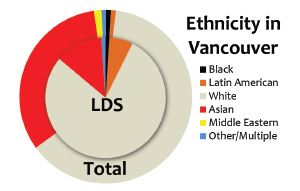British Columbia
Ruth Whidden Yates
Ruth Whidden Yates, “British Columbia,” in Canadian Mormons: History of the Church of Jesus Christ of Latter-Day Saints in Canada, ed. Roy A. and Carma T. Prete (Provo, UT: Religious Studies Center; Salt Lake City: Deseret Book, 2017), 178-209.

Although Ruth Whidden Yates grew up in northern Ontario, she has spent all of her adult life in British Columbia, living for a short time on Vancouver Island and then in the Vancouver area. She now lives in Merritt, a branch in the Vernon Stake. Ruth graduated from Brigham Young University with a major in English literature and has a master’s degree from Simon Fraser University in Canadian literature. She also has a teaching degree and a master’s in education. She worked in the Faculty of Education at Simon Fraser as coordinator of the Centre for Education, Law and Society, where she developed curriculum and courses in law for high school teachers. She has coauthored several business-law textbooks with her husband Richard, as well as edited and coauthored a number of educational resource books. She has served in almost every Church calling available to women, most recently as an editor for the Canadian Church website, canada.lds.org. She and Richard have five children and twelve grandchildren. (Ruth Yates)
 Beautiful British Columbia, with its rugged terrain and vast distances, has the second highest percentage (0.67percent) of Latter-day Saints in the total population of any Canadian province. Beginning with the first LDS family to move to the province in 1875 and the first branch of the Church in Vancouver in 1911, the growth of the Church has been augmented by many dedicated missionaries over several decades and many Saints moving to BC from elsewhere. The Church has grown and blossomed to include congregations throughout the province. In 2015, British Columbia had eight stakes and one district, as well as a beautiful temple.
Beautiful British Columbia, with its rugged terrain and vast distances, has the second highest percentage (0.67percent) of Latter-day Saints in the total population of any Canadian province. Beginning with the first LDS family to move to the province in 1875 and the first branch of the Church in Vancouver in 1911, the growth of the Church has been augmented by many dedicated missionaries over several decades and many Saints moving to BC from elsewhere. The Church has grown and blossomed to include congregations throughout the province. In 2015, British Columbia had eight stakes and one district, as well as a beautiful temple.
The story of The Church of Jesus Christ of Latter-day Saints in British Columbia, Canada’s third-largest province, is one of meeting physical as well as spiritual challenges. British Columbia has mountainous terrain, a rugged and largely inaccessible coastline, a wide range of climatic conditions, and distinctive geographical regions separated by vast distances. The building of Church communities by early pioneer Saints under these conditions took faith, dedication, hard work, and perseverance.[1] These hardy pioneers not only laid the foundation of the Church in the most westerly of Canada’s provinces, but they also built upon that foundation to establish branches, wards, and stakes. The dedication of the Vancouver British Columbia Temple in 2010 was the culmination of their courageous efforts; it was their fondest dream come true. This majestic edifice stands as a powerful symbol of the growing maturity of the Church in British Columbia and will serve as both a spiritual beacon and anchor for this and future generations of faithful Saints.
Potential Place of Refuge
In 1844, when Joseph Smith and Brigham Young recognized that the Saints would have to leave Nauvoo and were looking for a place to go, they considered Vancouver Island, a large island thirty kilometres off the west coast of North America. They appealed to Great Britain, which had vast colonial territories in the area, for a grant of land. The territory that included Vancouver Island was essentially unorganized at the time. Neither Britain nor its colonies were in a position to think about accommodating a large group of people seeking refuge from the American territories, particularly because the division of land at the 49th parallel had not yet taken place and the borders that encompassed present-day Oregon and Washington were still in dispute. No response was given to their inquiries, and the Saints looked elsewhere for a refuge.[2]
Charles O. Card, on assignment from then President of the Church, John Taylor, to find a gathering place in Canada, passed through southern British Columbia in 1886 looking for a suitable place to begin a Mormon settlement. He was disappointed to find that the very appealing land in the Okanagan Valley had already been divided up and occupied by ranchers and farmers or set aside for native reservations. Card continued eastward and finally settled in southern Alberta in 1887. During the settlement period for the Mormons in western Canada, there was little growth of the Church except for the communities surrounding Cardston, Alberta.[3]
History and Geography
British Columbia is separated geologically from the rest of Canada by the Rocky Mountains. Before Confederation, it was a British colony governed by the Hudson’s Bay Company from the town of New Westminster, located near the mouth of the Fraser River. The colony’s inclusion in the Dominion, when Canada was created in 1867, depended on the commitment of the new Canadian government to build a railway that would connect British Columbia to the rest of the country. Although the railway was not completed until 1885, British Columbia entered Confederation as the sixth province in 1871, and Victoria, the town at the tip of Vancouver Island, was chosen as British Columbia’s capital city.[4] The national government also committed to develop a network of seaways and roadways that would link the disparate areas of the new province.
Generally, the factors that contributed to the movement of people into the province and their location in its regions explain how members of the Church came to settle as well. British Columbia is divided geographically into six distinctive habitable areas. These played a large role in determining how and when members of the Church would make a foothold in the province. The lack of connection between these regions made it hard for the LDS Church to develop as a whole across the province; rather, each area has had its own largely independent story.
The southwestern corner of the province was the first area to be populated. It consists of Vancouver Island and the Lower Mainland. With the need for fur traders to search further afield for their goods and eventually the discovery of gold in the interior, traders, miners, loggers, and ranchers gradually moved northward toward Cariboo Country, home to mountains, high grassland plateaus, and extensive forests. Further to the west, settlements would develop along coastal inlets where fishing and logging resources were available for development and export.
The Thompson River area and the temperate zones of the Okanagan Valley in the southern interior were ideal for cattle ranching and fruit orchards, and this potential for development brought another wave of migrants to British Columbia. At the same time, settlers from Europe, Alberta, and the northern states migrated into the Kootenay region to settle in the valleys of the Rocky Mountains in the southeastern corner of the province. This region featured rich soils and navigable lakes and rivers with potential for hydroelectric development. Still later, others ventured toward the northeast and the Peace River district, where the high prairies were ideal for growing newly discovered strains of hardy wheat, and by the middle of the last century the lure of oil and natural gas resources brought oil workers to the North.[5]
First Members
In the latter part of the nineteenth century there were but few members of the Church in British Columbia. In 1875, the Copley family came from Utah to Vancouver Island. With no other members nearby, William Francis and Maria Judson Copley managed on their own to keep the principles of the gospel alive in the hearts of their many children.[6]
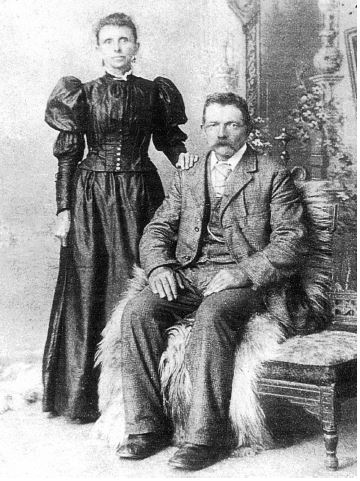 William and Maria Judson Copley and their young family were the first Church members in British Columbia, moving to Vancouver Island in 1875. (Edna Penn Collection)
William and Maria Judson Copley and their young family were the first Church members in British Columbia, moving to Vancouver Island in 1875. (Edna Penn Collection)
The first convert was Anthony M. Stenhouse, a member of the provincial legislature representing Comox on the northern half of Vancouver Island. He announced in 1887 that he was going to “join up with the Mormons”; then he resigned his seat and moved to Cardston, where he was later baptized. How he became acquainted with the Church is not known.[7]
Patterns of Church Growth
British Columbia became part of the Northwestern States Mission in 1902, and mission president Nephi Pratt organized the Victoria Conference in May 1903.[8] The first missionaries in Vancouver, on assignment from Portland, Oregon, in 1904, discovered the Neill family, Church members who had emigrated from Australia.[9] From that point until 1909, missionary efforts were sporadic throughout the province until Melvin J. Ballard, the president of the Northwestern States Mission, came to organize a branch in Vancouver in 1911 and called Brother Neill as its first president. By 1925, the Vancouver Branch had purchased the first LDS Church building in the province.
Members of the Church from Alberta, Utah, Idaho, Great Britain, and other European countries swelled the ranks, and began venturing north as the various areas of the province opened up. In some locations, early stalwart converts provided leadership. In most instances single families formed home Sunday Schools and then invited their neighbours to join them, leading to the first conversions. Growth patterns varied with the location, the stage of economic development, and the expansion of the Church’s missionary efforts. Slowly, the capacity of missionaries to reach into the more remote areas of the province increased.
During the 1920s, members from Alberta and Idaho settled in Creston, a border town in the Columbia Valley. In the 1930s, Sunday Schools were operating there, and the Okanagan Valley had its first convert, Wilhelmina James of Vernon. She was the lone member in the Okanagan Valley for twenty years. When the Vernon Branch was formed in 1947, James handed President Gregson the tithing she had saved and then served in the branch until she was asked to turn the first shovel of sod at the groundbreaking ceremony for the Vernon chapel in 1964.[10] Growth was tentative in the province’s interior, however, as members drifted back and forth across national and provincial borders and as the economy ebbed throughout the war and Depression years.
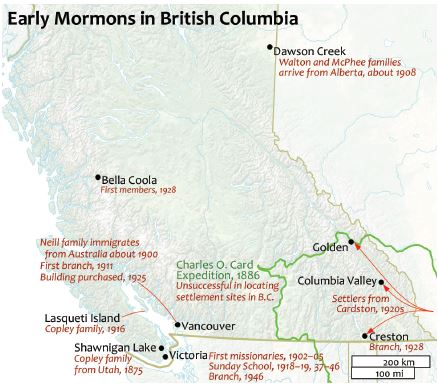
During the Second World War, the Alaska Highway project brought workers to the far north. Some stayed when they found good farmland on the northern prairie. Through the 1940s and early 1950s, opportunities for ranching and logging brought more American Church families to the Nechako Valley, in the central interior of BC. Other members were drawn further west to the port town of Prince Rupert and the aluminum-smelting town of Kitimat and to the Queen Charlotte Islands, where an armed-forces base working on the Distant Early Warning (DEW) Line brought both Canadian and US member families in the early 1960s. Being able to stay in these more remote areas of the province depended on the success or failure of the mines, wood and pulp mills, the completion of power projects, and the building of rail and highway corridors. Some of the American families stayed for several generations and contributed to the growth and development of the Church in their respective areas. Throughout this period, depending on the number of missionaries in the field, missionary work continued and the fledgling branches of the Church grew.
In this brief chapter, it is not possible to account for every member family and branch, but it is hoped, nonetheless, that their pioneering experiences and achievements are recorded in personal journals and family histories and preserved for their descendants to cherish.[11]
It is also important to keep in mind several realities that were common for all of the early members in remote areas. Church leaders had to cover great distances, with many obstacles in their way, to organize and support units in distant valleys. Missionaries were not always available for remote area assignments. Curriculum materials were only sporadically available, and the members lacked the benefits of modern media to provide consistent contact with the General Authorities of the Church in Utah. In many instances the members were transient, moving from one place to another in search of satisfactory employment. These factors added to the complexity of fostering a community of Saints and building branches. The family of Roy and Yvonne Salter, featured in the sidebar, is an example of this phenomenon.[12]
While there has been steady growth in the Church in British Columbia as the following timeline indicates, it is important to remember that Church membership fluctuated over time because of economic growth or decline. World events that affected the number of missionaries in the field, immigration patterns, and changes in the demographic of large cities have resulted in members moving to suburbs or smaller towns where housing was less costly. As such, cities where the Church had vibrant memberships in the 1960s and 1970s may have seen their numbers subsequently diminish. In the north and southeast, particularly, mines and mills in small towns opened in the 1950s and 1960s, offering employment and reasonable housing. But, as those industries suffered downturns, younger families had to look elsewhere for employment. During the 1990s (in Vancouver especially) the Saints welcomed many immigrant members, particularly from South and East Asia and South and Central America, who brought with them a great desire to live the gospel in their new homeland.[13]
Over the years, especially after World War II, many families immigrated to British Columbia seeking greater opportunities, eventually making a significant contribution to building up the Church. Some of the immigrants who moved from Europe were already Latter-day Saints, such as Soren and Mary Hoyrup (England/
In 2016, there were eight thriving stakes and one district located in British Columbia. In addition, east of the Rockies, on the east-central border of British Columbia, the Fort St. John and Dawson Creek Wards are part of the Grand Prairie Alberta Stake. Additionally, the Cranbrook Stake, with its close proximity to Alberta, is in the Cardston Temple region.
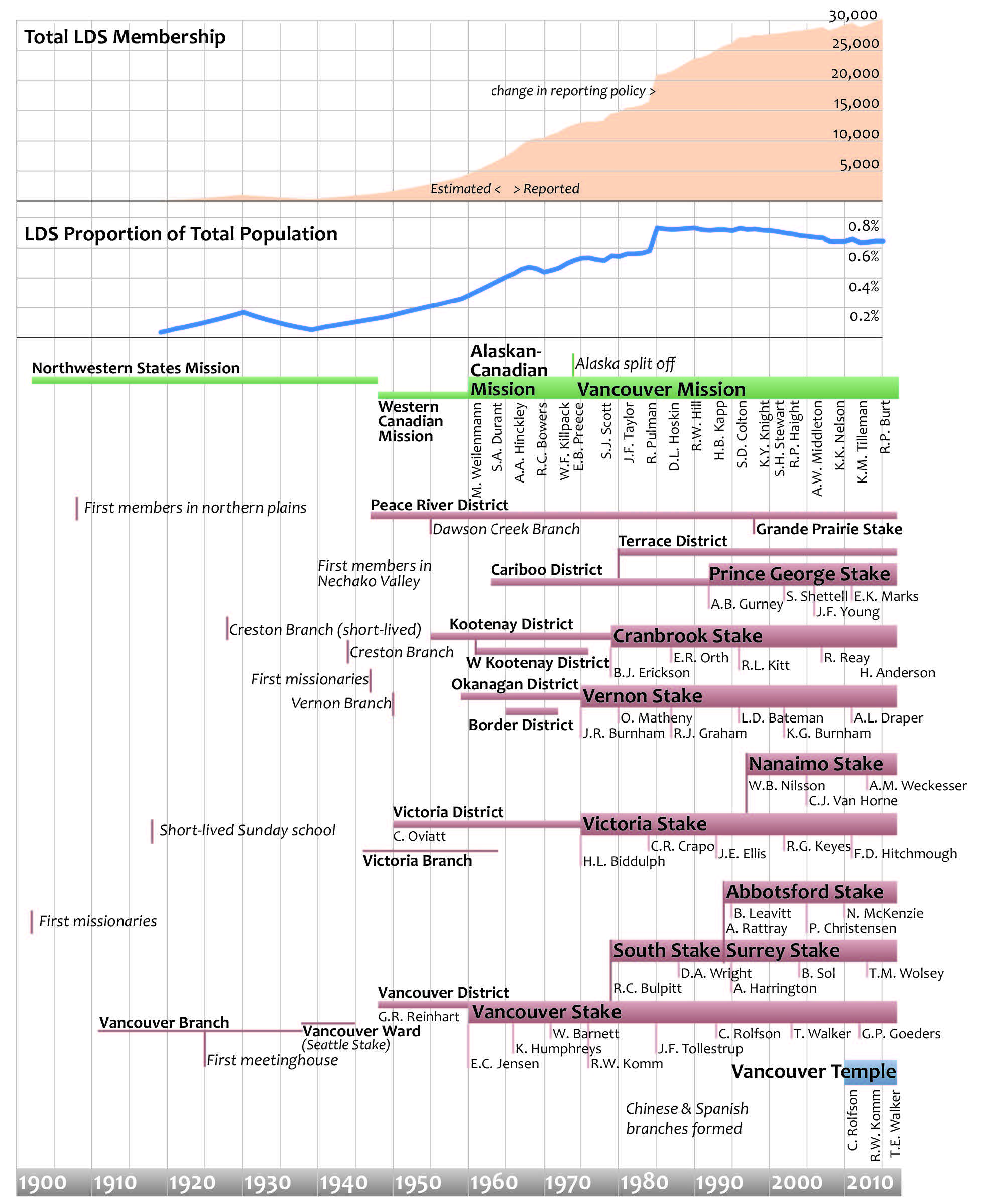
Missions, Districts, and Stakes
The timeline below sets out the major milestones in the history of the Church in each of the distinctive areas of BC. Following the timeline is a more detailed outline of the development of branches, wards, and stakes in each of the six areas of British Columbia, beginning with the first areas where members were present and proceeding to the parts of BC where Church membership has developed more recently. A description of the development of the Church in the various regions of the province illustrates many of the themes alluded to above.
Vancouver and the Lower Mainland
The first record of members in Vancouver is in 1903. They were three members of the Neill family who had joined the Church in Australia and a convert named Daniel Davidson, who had travelled to Seattle to be baptized.[17] In 1909, Melvin J. Ballard, the new president of the Northwestern States Mission, visited Vancouver and presided over its first conference, where twelve members were present. Two years later President Ballard returned to organize the first branch in Vancouver with Edward Neill as president.[18] The first recorded social event was held in 1911, and it was noted that “the women were always there to help and encourage and brought about a unity so needed at the time.”[19] When the second conference convened in 1912, there were eighty members present. That same year, the first missionary from Vancouver, Edwin Emerson Pinckney, was called to serve in Great Britain.[20]
A few years later, the Rimmers immigrated to Canada, settling in Vancouver, British Columbia. They were faithful, contributing members of the Vancouver Branch and served in several responsible callings.[21] (Edna Penn Collection).
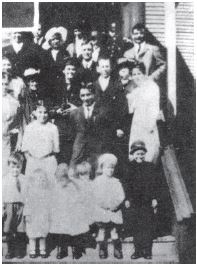 The Vancouver Branch in 1915, which included seven members of the Copley family. (Edna Penn Collection)
The Vancouver Branch in 1915, which included seven members of the Copley family. (Edna Penn Collection)
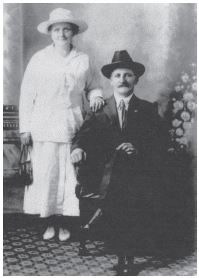 Emily and James Rimmer. (Edna Penn Collection)
Emily and James Rimmer. (Edna Penn Collection)
In April 1916, the branch organized its first Relief Society, and the women joined in the efforts of the branch to raise money to rent a hall and to acquire the funds to purchase their own building. They knitted, sewed, baked, made candy, and held bazaars to help accomplish this goal. Their efforts were successful. The first meeting in their own building was on 6 September 1925 with about one hundred members present. In order to make the building more appealing, the women and girls scrubbed the floors, made cushions for the wooden benches, and sewed a curtain for the rostrum. [22]
 The Vancouver Branch, after meeting for years in homes and rented halls, purchased this meetinghouse, located at 804 East 14th, in 1925. (Edna Penn Collection)
The Vancouver Branch, after meeting for years in homes and rented halls, purchased this meetinghouse, located at 804 East 14th, in 1925. (Edna Penn Collection)
 Members of the Vancouver Branch, 1926, standing at the side of their recently acquired meetinghouse. (Edna Penn Collection)
Members of the Vancouver Branch, 1926, standing at the side of their recently acquired meetinghouse. (Edna Penn Collection)
By 1935, the benches were replaced with handcrafted wooden pews, and work began to dig out a basement to accommodate a recreation hall, office, kitchen, and classroom. A baptismal font was added, which had to be filled and emptied by hand. One young candidate for baptism there, Adrian Toolson, reported that the water was very cold.[23]
Women of the Vancouver Branch Relief Society, with a few of their children, 1940. (Edna Penn collection)
When Canada entered the Second World War, twelve men from the Vancouver Branch joined the Canadian Forces, and the Relief Society contributed to the war effort by knitting for the men overseas and providing necessary goods to members suffering in Europe. Following the war, membership grew significantly; young men began serving missions and more missionaries came to serve in Vancouver.
These two photographs of the New Westminster Branch illustrate the rapid growth of the Church in the Lower Mainland during the 1940s. The photo on the top was taken in 1942, and the one below it, in 1946. (Photos from Alden Smith Collection)
In November 1947, British Columbia became part of the Western Canadian Mission, centred in Edmonton, Alberta.[25] The Vancouver District was organized in May 1948, with local member Garreth J. Rynhart as president, with branches in Vancouver, New Westminster, and Victoria.[26] Soon a building for the New Westminster Branch was approved, and land was purchased at 538 10th Street in New Westminster in 1948. The new chapel was ready for occupation by 1950 for the sixty or so members who had been meeting in a number of local halls since 1942.[27] The number of branches in the district had increased to six by 1952 and by then, it was time to consider building a new chapel in Vancouver.
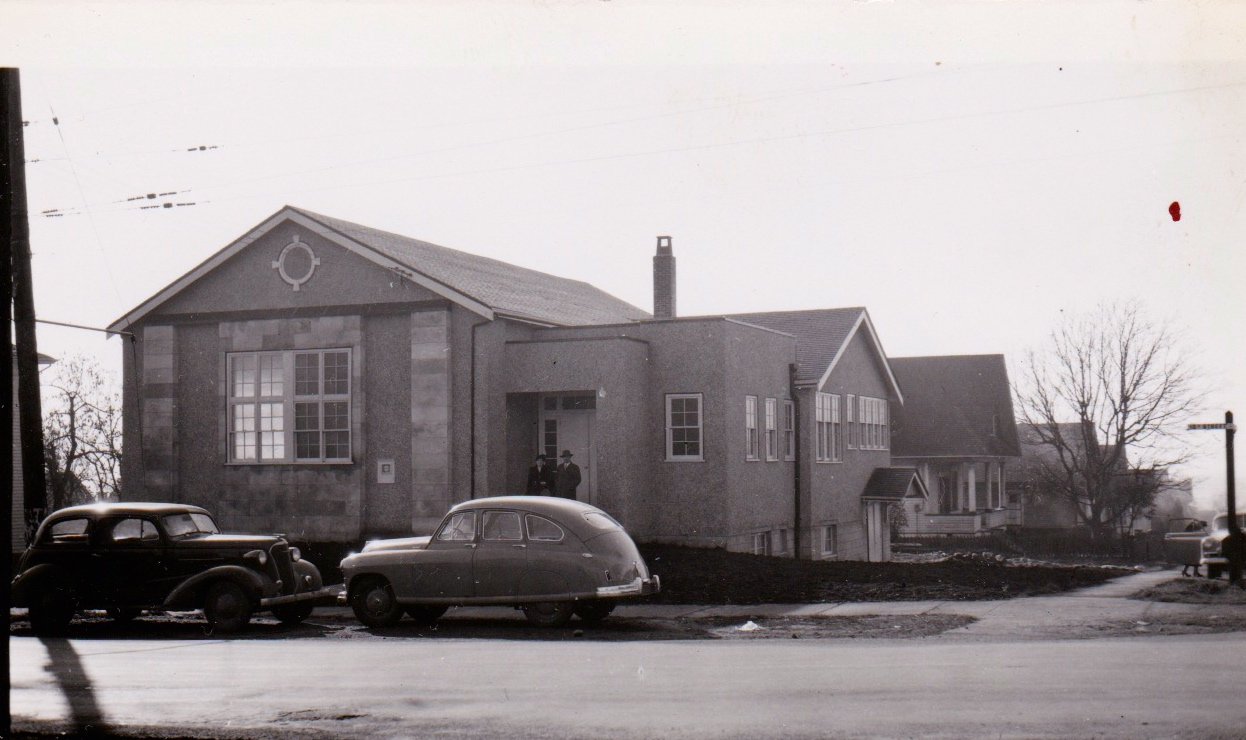 The New Westminster meetinghouse was dedicated in 1950[28] and occupied until it was sold to help fund the building of the Vancouver Stake Centre in Burnaby in 1965. (Alden Smith)
The New Westminster meetinghouse was dedicated in 1950[28] and occupied until it was sold to help fund the building of the Vancouver Stake Centre in Burnaby in 1965. (Alden Smith)
With funds raised by the members, the Church purchased land on 41st Avenue in Vancouver, and a groundbreaking ceremony was held in June of that year. Members laboured under the direction of E. Lyle Burgess, a member of the branch, to erect the building. While it was under construction, Burgess managed also to build a small fishing boat in the area where the chapel was being built. He might have been looking forward to the day when there would be some time to do some fishing with his boys.[30] President David O. McKay dedicated the new chapel on 1 August 1954. Twelve hundred members gathered for the occasion. “Therefore when we build,” he said, “let us think that we build forever. . . . Let it be such work that our descendants will thank us for it and let us think as we lay stone on stone that a time is to come when those stones will be held sacred because our hands have touched them.”[31]
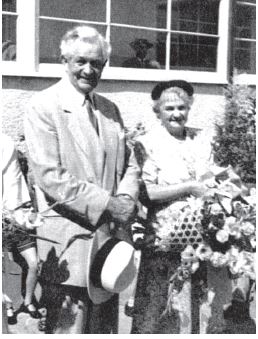 David O. McKay, President of the Church, and his wife, Emma, visited Vancouver in August 1954, where he dedicated the first LDS meetinghouse to be constructed in Vancouver. (Edna Penn Collection)
David O. McKay, President of the Church, and his wife, Emma, visited Vancouver in August 1954, where he dedicated the first LDS meetinghouse to be constructed in Vancouver. (Edna Penn Collection)
The building spurred growth, and by 1958, the Vancouver Branch was divided. The First Branch included Vancouver and Richmond, and the Second Branch served East Vancouver and Burnaby.
The Vancouver Stake was organized by Hugh B. Brown of the Quorum of the Twelve in 1960, assisted by N. Eldon Tanner and Franklin D. Richards, Assistants to the Twelve. Along with the two Vancouver wards, there were now wards in North Vancouver, New Westminster, Surrey, Richmond, White Rock, Langley, and Chilliwack. Ernest E. Jensen was the first stake president.[32] At the same time, the Western Canadian Mission was divided and British Columbia became part of the Alaskan-Canadian Mission.[33] Work then began on the plans for a stake centre in Burnaby and a new chapel in North Vancouver. In 1966, under the direction of the new stake president, Keith Humphreys, a groundbreaking ceremony was held. With a renewed effort to raise funds and the dedication of members, the stake centre was completed and dedicated on 22 October 1967.[34]
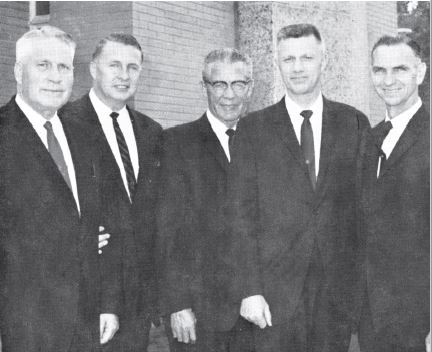 The Vancouver British Columbia Stake Centre was dedicated 22 October 1967 by N. Eldon Tanner. Left to right: Arza A. Hinckley, president of the Alaskan-Canadian Mission; Archie D. Evanson, counselor in stake presidency; N. Eldon Tanner of the First Presidency; Keith M. Humphries, stake president; and E. Lyle Burgess, counselor in stake presidency.[36] (Edna Penn Collection)
The Vancouver British Columbia Stake Centre was dedicated 22 October 1967 by N. Eldon Tanner. Left to right: Arza A. Hinckley, president of the Alaskan-Canadian Mission; Archie D. Evanson, counselor in stake presidency; N. Eldon Tanner of the First Presidency; Keith M. Humphries, stake president; and E. Lyle Burgess, counselor in stake presidency.[36] (Edna Penn Collection)
Music was always an important component of living the gospel in British Columbia. After a performance by the Mormon Tabernacle Choir in Vancouver and a choral workshop by Richard P. Condie, the Choir’s director in 1963, the stake focused on improving its choral presence. In 1966, the Singing Mothers from the Vancouver Stake performed in Washington State with the Singing Mothers of the Cascade Stake in preparation to sing in Salt Lake City at the general Relief Society conference and the Saturday afternoon session of general conference that October.[37] The Singing Mothers of the Vancouver Stake also sang in a combined choir in the October 1966 general conference in the Tabernacle in Salt Lake City. Florence Jepperson Madsen directed the choir.[38]
The Vancouver Stake was divided in 1979, creating the Vancouver South Stake, which included the area south of the Fraser River, with Richard Bulpitt as the stake president. Bulpitt served until 1988, when Dennis A. Wright became president of the newly named Surrey Stake. The Surrey Stake Centre was completed in 1992, just in time to begin preparations for yet another stake in the region. Andrew Rattray, who served as a counselor under President Wright, was called in 1994 to be the first president of the Abbotsford Stake, which was composed of the Port Coquitlam, Maple Ridge, Langley, Abbotsford, Mission, and Chilliwack wards.
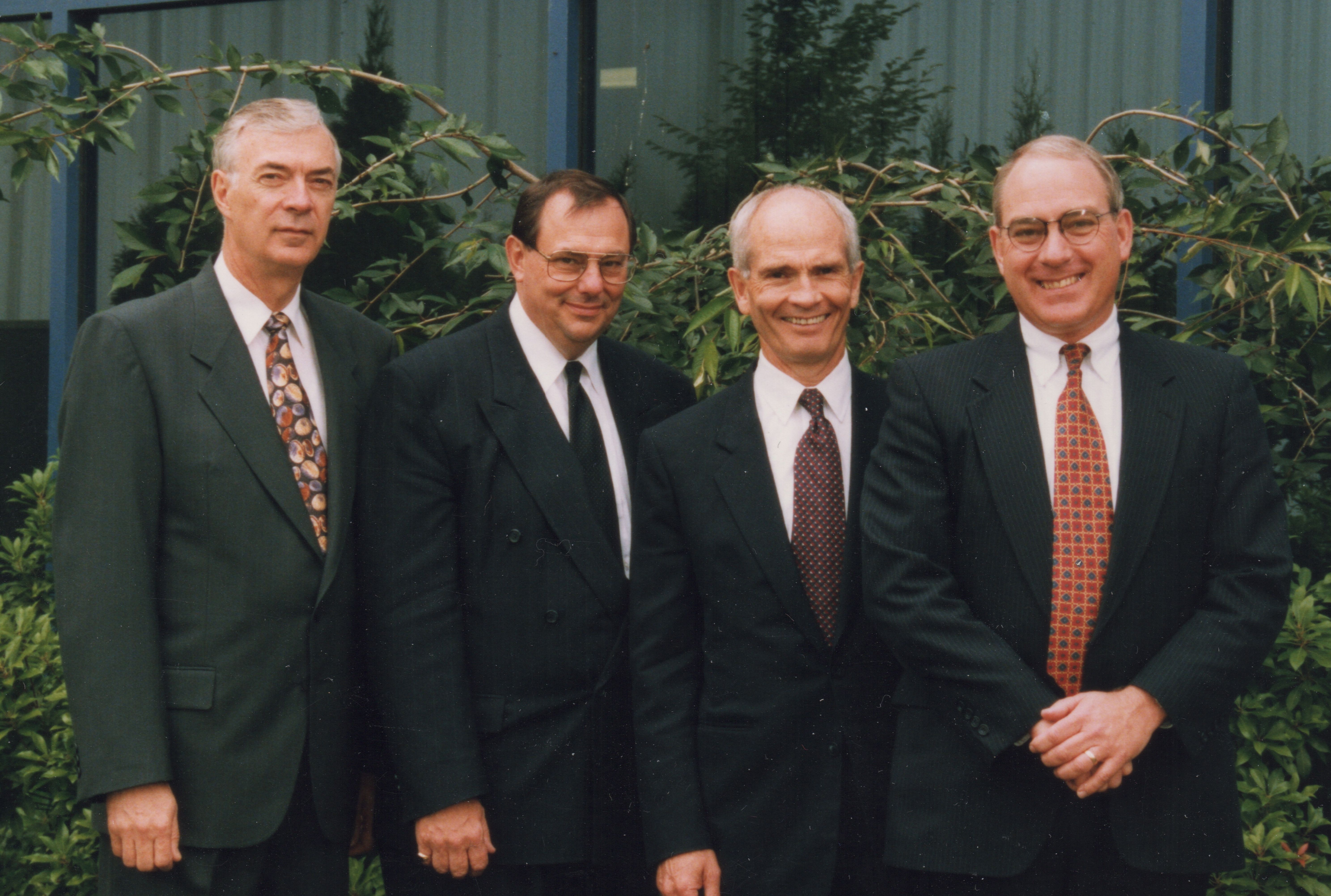 Lower Mainland stake presidents during the 1980s. Left to right: Ronald Komm, Richard Bulpitt, Jon Tollestrup, Dennis Wright. (Photo taken in the early 1990s by Cordell Rolfson)
Lower Mainland stake presidents during the 1980s. Left to right: Ronald Komm, Richard Bulpitt, Jon Tollestrup, Dennis Wright. (Photo taken in the early 1990s by Cordell Rolfson)
In 1980, with the dedication of the Seattle Temple, there was greater opportunity for BC members to attend and serve in the temple. The temple dedication was a significant event for Canadian members, who provided a women’s choir and helped manage the open house and dedication activities. In spite of the three-hour drive, members of the British Columbia stakes faithfully attended and were grateful for the opportunities to serve that came with having a temple nearby. Until that time, British Columbian Latter-day Saints had to drive or fly up to 1,500 km to the nearest temple in Cardston, Alberta, to receive their temple ordinances.
 Flying to the temple. On 16 September 1961, members of the Vancouver Stake boarded a chartered plane bound for Lethbridge, Alberta. From Lethbridge, they travelled by bus to the temple in Cardston. This was the first of several such temple trips. (Adrian Toolson)
Flying to the temple. On 16 September 1961, members of the Vancouver Stake boarded a chartered plane bound for Lethbridge, Alberta. From Lethbridge, they travelled by bus to the temple in Cardston. This was the first of several such temple trips. (Adrian Toolson)
Vancouver Island
It may be said that William Francis Copley, his wife, Maria Judson Copley, and their family established a prototype for how the gospel would come to British Columbia. They left Utah and settled on the south-central eastern coast of Vancouver Island in 1875. The family grew, but because there were no other Church members and no contact with the Church, the children were not baptized. However, they were never allowed to forget the teachings and principles of the gospel. In 1902, British Columbia was added to the Northwestern States Mission, and the following year the mission president, Nephi Pratt, organized the “Victoria Conference” and called William M. Swan, a missionary from Salt Lake City, as president. Missionaries were preaching on the corner of Yates and Government Streets in Victoria when two young Copley boys, visiting the city from their home “up-island” in Shawnigan, spotted them, and returned home to tell their mother, “who got on the next stage to Victoria, found the missionaries and fell on them with rapture.” The missionaries came back to Shawnigan with her and taught the whole family, baptizing the younger ones and rebaptizing the older generation.[39]
The Copleys were some of only a few members of the Church in British Columbia when the missionaries were withdrawn in 1905. Some of the Copley family went back to Utah to live, but two sons, Fred and Merien, who had married sisters, Hattie and Birdie Owens, in 1910 while in Fillmore, Utah, returned to Vancouver Island to live with their young families. In 1916, the Copley families moved to live and work on Lasqueti Island in the Strait of Georgia, about eighty kilometres north of Vancouver. In 1933, on another rare visit from full-time missionaries, a Sunday School was organized. Eventually, new members came, and a branch with about twenty-five members was formed on Lasqueti Island.[40]
By 1918, there were five families in Victoria, and the first Sunday School on the Island was organized. However, because there was little growth, missionaries were again withdrawn, and members in Victoria lost contact with the Church. It wasn’t until 1937 that Melvin Oxspring moved to Victoria, and at his request, missionaries visited once again. A Sunday School was organized with ten adults and seven children. Sister Una Hillier, as a counselor in the Sunday School, provided the continuity over the next ten years as she served in the Sunday School and as Relief Society president.[42] In 1942, a dependent branch was organized, which became an independent branch in 1946 with Rex Nielson as the first branch president.[43]
There was a good deal of mission and district reorganization during the period from 1947 and 1949. British Columbia was added to the Western Canadian Mission in 1947, the Vancouver District included Victoria and Nanaimo in 1948, and the Victoria missionary district was created in July 1949.[44] In 1959, the Victoria District was organized with local leadership. Conrad Oviatt of Nanaimo served as the first district president, with Eldon C. Ellis of Port Alberni and Albert Isfeld of Victoria as his counselors. Each of these men continued to serve concurrently as president of his local branch.[45]
In November 1960, British Columbia, including the four Vancouver Island branches of Duncan, Nanaimo, Port Alberni, and Victoria, became part of the new Alaska-Canadian Mission, with headquarters in Vancouver.[46] Comox was added to the Victoria District in 1962, and Powell River, situated on the mainland but only accessible by water, was made a branch in 1967.[47] In 1964, the Victoria Branch was divided.[48] The second meetinghouse on the island was in use in Victoria before the end of 1960, and the third was begun in Port Alberni in 1963. Early in 1972, the Sydney Branch was added along with the Colwood Branch in 1973.[49]
On 9 February 1975, Boyd K. Packer of the Quorum of the Twelve presided at the organization of the Victoria British Columbia Stake. Howard L. Biddulph, who had served as district president for the previous two years, was called as the first stake president. The Colwood, Nanaimo, Port Alberni, and two Victoria branches became wards, with the units in Courtenay (Comox), Duncan, Powell River, and Sidney remaining branches.[50] Another branch has since been organized on Salt Spring Island.
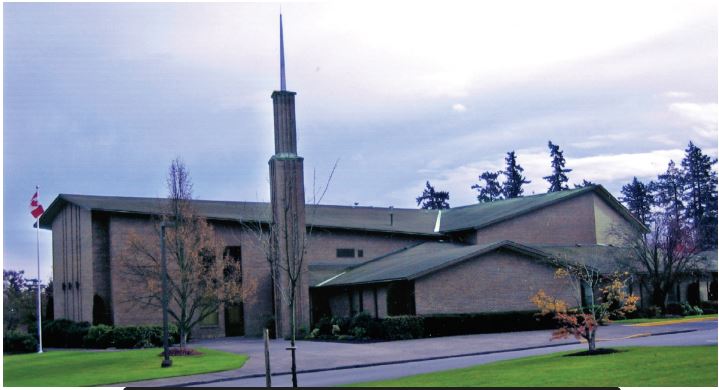 The stake centre of the Victoria British Columbia Stake was dedicated in 1982. (Edna Penn Collection)
The stake centre of the Victoria British Columbia Stake was dedicated in 1982. (Edna Penn Collection)
Growth continued unabated over the next two decades. The Nanaimo British Columbia Stake was created in 1997, with William B. Nilsson as the first stake president.[51] The Nanaimo Stake, in 2016, included five wards: Nanaimo, Duncan, Courtenay, Campbell River, and Port Alberni; and three branches: North Island, Powell River, and Qualicum.[52]
The Kootenays and the Columbia Valley
This region, located in the southeastern section of the province, is separated from the rest of British Columbia by two chains of mountains, and the view of its residents tends to be directed toward the east and Alberta. There have been Latter-day Saints in the Columbia Valley since the 1920s, scattered from the town of Golden in the north to Invermere, Fairmont, and Creston near the Canada-US border. Members first came to the Creston Valley during the 1920s from Cardston, Alberta, or from across the border in the adjacent states of Montana, Idaho, and Washington. In the summer of 1928, there were enough members to organize a small branch. But numbers fluctuated over the next decade, and the branch was disbanded. Alfred May, visiting regularly from Porthill, Idaho, in 1937, reassembled the diverse group and worked hard to get the branch up and running again. He provided transportation for many families so the group could get together for Church services. Sunday School continued and was held in many local homes and halls, including a little log cabin situated on the banks of Goat River. The fast-flowing river was the place of a number of baptisms.[53]
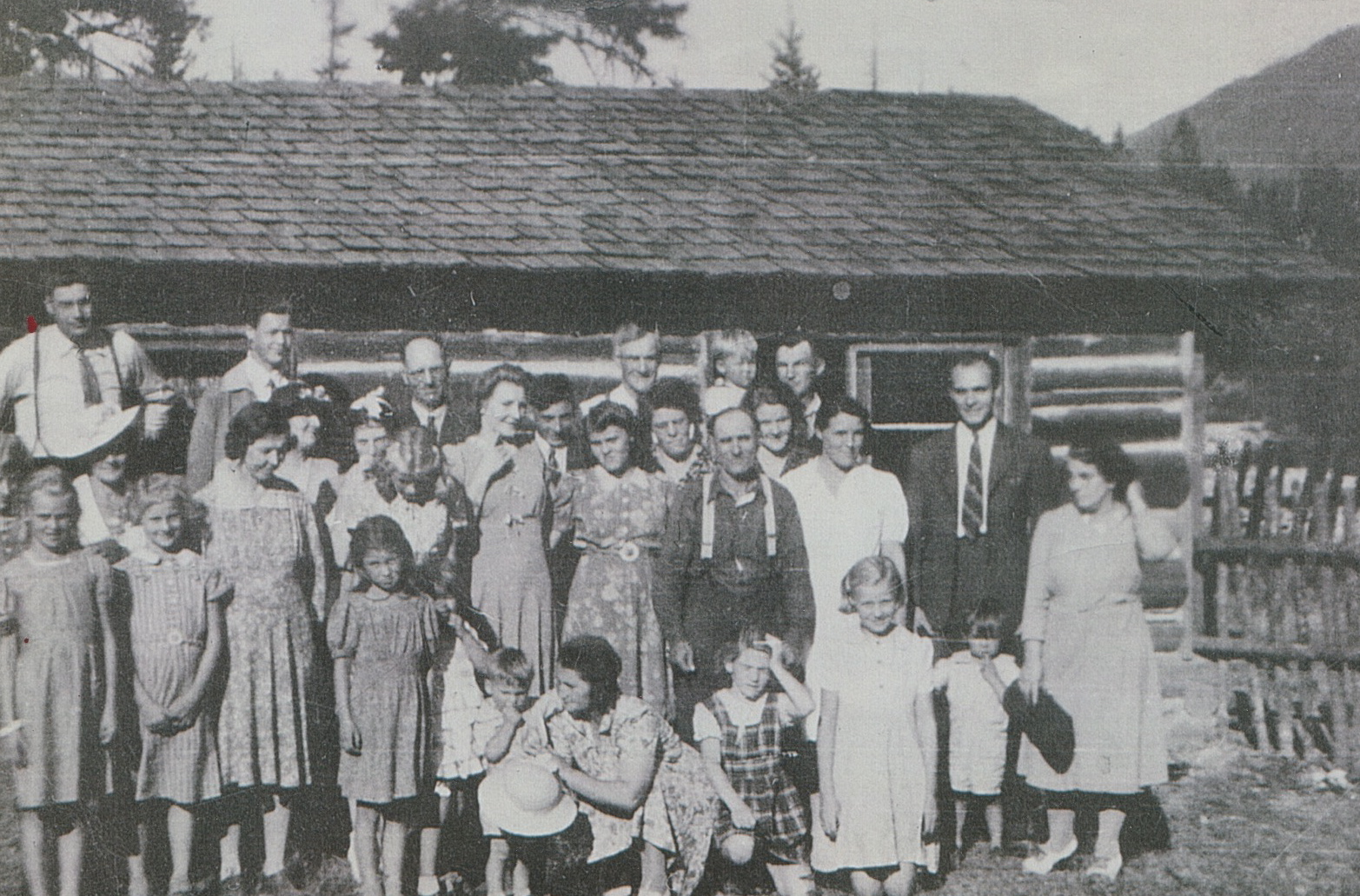 Members of the Church in front of the “little log cabin” chapel on Goat River. (Darla O’Dell)
Members of the Church in front of the “little log cabin” chapel on Goat River. (Darla O’Dell)
The progress of the Church led to the reconstitution of the Creston Branch in 1944. A meetinghouse site was selected in Erickson, which was central to the people travelling from Creston, Canyon, and Arrow Creek. When the building was completed in 1949, it would be the first Latter-day Saint meetinghouse built by Church members in British Columbia. At that time, there were 120 Church members in the area.[54] In 1955, a home Sunday School was instigated at Kingsgate, which continued until Kingsgate and Creston Branches were amalgamated and became a ward in 1970. A new chapel was built on Knight Road in Creston in 1981, and the membership in Creston in 2014 was 320.[55]
Meanwhile, after British Columbia became part of the Western Canadian Mission, an independent branch was organized in Cranbrook in 1948, with George Atwood as president. Atwood began a concerted effort to acquire a building for the small branch. George and his wife, Eliza, took the cab off their truck and visited all the Church member farmers within fifty miles, asking for donations to the building fund. He got the same answer everywhere he went, “No Money.” However, George said, “If you don’t have any money, you do have calves, pigs, sheep, chickens, etc.” He would take whatever they would give him. It took many daylong trips to pick up all the donated animals and deliver them to buyers.[56]
Obtaining a property on which to build posed some challenges. The branch presidency found they could purchase three good lots, but they needed a fourth so they could build the church on a corner. One woman, a nonmember, had purchased the fourth lot. When President Atwood explained why he wanted the lot, she sold him the land for the price she had paid for it. Two hundred people attended the dedication for the new meetinghouse in the spring of 1950.[57]
 The Cranbrook chapel was dedicated in 1950. (Darla O’Dell)
The Cranbrook chapel was dedicated in 1950. (Darla O’Dell)
In 1960, the Kootenay District was transferred from the Western Canadian Mission to the new Alaskan-Canadian Mission. The district included branches in Cranbrook, Creston, Jaffray, Kimberley, Kingsgate, Nelson, and Trail. Another independent branch was created in Jaffray in 1962. In 1963, the members in Kingsgate held their first meetings in a building they had built by themselves from salvaged lumber.[58]
The Cranbrook British Columbia Stake, the fourth stake to be organized in the province, was created in 1979, with Brian Erickson as the first stake president. The stake consisted of two wards in Cranbrook and wards in Trail, Sparwood, and Creston, with branches in Fairmont, Grand Forks, Nelson, and Crawford Bay.[59] The branches in Sparwood and Trail later became wards, with young and vibrant members who took advantage of the stunning mountains that surrounded them and all the outdoor activity they inspired. [60] The Cranbrook Stake in 2016 consisted of two wards in Cranbrook, with one ward each in Creston, Sparwood, and Trail, and branches in the Columbia Valley, Nelson, Jaffray, and Kootenay Lake.[61]
Vernon Stake
Vernon is a jewel of a city perched on the northern end of the Okanagan Valley. The city is centrally located in a stake that ranges from Osoyoos near the US-Canadian border on the south to Clearwater in the north, a distance of over four hundred kilometres, and from Lytton and Merritt in the west, to Revelstoke in the east, another distance of almost four hundred kilometres. This is a vast and beautiful area of south-central British Columbia.
As part of the same Northwestern States Mission that covered Vancouver Island and the Lower Mainland, the Okanagan region did not have the benefit of missionaries until 1947, when a home Sunday School that had been established in Vernon was organized into a branch with Percy Gregson as the presiding elder.[63] At the same time, in Kelowna, to the south, three LDS families organized a Sunday School. As their numbers grew, Kelowna also became a branch. A branch was organized in Penticton with twenty-five members in 1951, and another group in Kamloops became an independent branch in 1960.[64] The four branches were organized into the Okanagan District in 1959, under the direction of the Western Canadian Mission, and Percy Gregson became district president.[65] The next decade saw a threefold increase in Church membership in the area. The first dedicated meetinghouse was built in Penticton in 1961. In Vernon, work began on the first phase of a meetinghouse in 1964, and the second phase began in 1971 under the supervision of Bill Streibel. The cultural hall was completed in 1973.[66]
 Vernon meetinghouse under construction. Church membership in the Okanagan area increased threefold in the 1960s, necessitating the construction of more Church buildings. This three-phase meetinghouse, dedicated 8 December 1974, became the first stake centre in the interior of British Columbia in 1975, when the Vernon British Columbia Stake was formed.[67] (Shirley Burnham)
Vernon meetinghouse under construction. Church membership in the Okanagan area increased threefold in the 1960s, necessitating the construction of more Church buildings. This three-phase meetinghouse, dedicated 8 December 1974, became the first stake centre in the interior of British Columbia in 1975, when the Vernon British Columbia Stake was formed.[67] (Shirley Burnham)
With the growth of Church membership in the Okanagan District and the construction of new meetinghouses, the goal of stakehood seemed within reach. In 1974, E. Bruce Preece, president of the Canada Vancouver Mission, visited the district and encouraged the members to seek for stakehood, saying, “If the people of this district will show the desire and determination, this district will become a stake in two years.” President Preece told them of a dream in which he was trying to milk a cow, but “she would not let her milk down.” He glanced down and saw that the bucket was dirty. When he cleaned the bucket, the milk flowed abundantly. “Cleansing the inner vessel” became a mission theme.[68] In response, J. Ronald Burnham, president of the district, declared a district goal in early 1975 for the district to become a stake by December. The mission presidency and the Regional Representative began an intensive training program to prepare the leadership to meet the demands of stakehood, and by early fall it became evident that the 2,448 members were ready to make that leap.[69] In 1975, the Okanagan District became the Vernon British Columbia Stake, with J. Ronald Burnham as president.[70]
In 1980, under direction from the First Presidency, the Vernon Stake was asked to acquire and maintain a welfare orchard.[71] There was concern expressed that the membership, which was already taxed with the funding of ward buildings and the Seattle Temple assessment, could not carry the financial burden, but the leaders were instructed to purchase the orchard on faith. In 1983, their faith was rewarded when the Church no longer required local funding for building and welfare projects.[72]
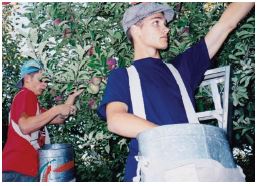 Michael Cirillo and Christopher Hubbard picking apples in the welfare orchard. (Michael Cirillo)
Michael Cirillo and Christopher Hubbard picking apples in the welfare orchard. (Michael Cirillo)
For Vernon Stake members, temple service has always been an important part of their commitment to the gospel. Shirley Burnham recalled how that service was accomplished:
In April 1975 there was a typical district youth temple trip to Cardston. Fifty-four youth travelled 11 hours by bus and arrived at 3:30 am. Wayne and Karen Olsen, former residents of Vernon, took them in. The return trip took 15 hours because the bus broke down. The total cost was $1,175. On November 17th 1980 the Seattle temple was dedicated and became the Vernon Stake’s assigned temple. It was closer for most of the stake, but the cost of accommodations was much higher. Clifford Oviatt of Penticton, the high counselor in charge of temple work, decided to help. He and his wife, Margery, bought a home near the Temple. Members could book a room for ten dollars and leave the money in an envelope in the kitchen. Many adults from our stake became ordinance workers in the Seattle Temple traveling monthly to fill their assigned shifts all in a cluster rather than once a week.[75]
Much dedication and sacrifice were required of those who were called as leaders in the large Vernon Stake. An outstanding example of this is Robert J. Graham, who became president of the Vernon Stake in 1987. Before moving to Kamloops, Graham had already served as a counselor in the East Kootenay District presidency and as a counselor in the Cranbrook Stake presidency. Then he served as counselor to each of the first two presidents of the Vernon Stake. Accepting the call to serve as stake president required another nine years of travelling one and a half hours in each direction weekly from Kamloops to Vernon for stake meetings, as well as visiting wards and branches throughout the stake. He trained many for leadership by having stake officers and high counselors serve a maximum of three years before returning to their wards for service there. During his tenure, an increase in membership enabled the Merritt Branch to be established once again and Revelstoke to become a dependent unit of the Salmon Arm Ward. The Kelowna Third Branch was established in Kelowna for all young single adults in the stake. After nine years of service as stake president, Graham continued to contribute to the growth of the Church and was in 2016 serving in the Vancouver Temple. His life of service and sacrifice is typical of many leaders who have served the Church in British Columbia.[76]
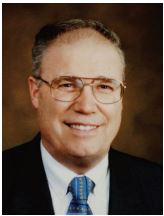 Robert J. Graham, president of the Vernon British Columbia Stake from 1987 to 1996, is an example of selfless service and dedication. (Robert J. Graham)
Robert J. Graham, president of the Vernon British Columbia Stake from 1987 to 1996, is an example of selfless service and dedication. (Robert J. Graham)
In due course, dedicated meetinghouses were built in Kelowna, Kamloops, Penticton, and Salmon Arm. West Kelowna and Merritt acquired smaller chapels in 2008 and 2009. Osoyoos purchased a building and converted it to meet the branch’s needs. In 2016, the Clearwater Branch was holding meetings in a rented school, which they had converted for branch use. Senior couple missionaries had often been called from within the stake to move to and give support to the outlying branches, and their dedicated service did much to encourage growth.[77]
Peace River Country
Dawson Creek and Fort St. John are located along the Peace River on a high prairie plateau in northeastern British Columbia. These two small but vibrant cities, along with Chetwyn, are geographically closer to Alberta and became part of the Grande Prairie Alberta Stake when it was formed in 1998.
There were only two known members of the Church in Dawson Creek in the early 1940s: Joel Walton, who homesteaded in the Pouce Coupé area seven miles east of Dawson Creek, had arrived in 1908; Mary McPhee also arrived in the area during this early period. The Peace River District was established 1947, five years after the completion of the historic Alaska Highway. Dawson Creek members met in various homes and halls from 1948 until they were organized as a branch in January 1956, with Delbert Fuhriman as the first branch president. Church members from Fort St. John and Taylor travelled to Dawson Creek to attend meetings.[78]
The Dawson Creek Branch dedicated a meetinghouse in 1968. Although activity for the approximately eighty members in this large district was challenging, an early Relief Society president is quoted as saying, “What I remember is the friendliness of the sisters, their concern for one another and how hard they tried to live the lessons they were taught. They had the sweet spirit of the Lord with them and a unity that is seldom seen. How very blessed we were.”[79] Many fund-raising projects, such as selling homemade chili and root beer at the local rodeo, chocolate making at Christmastime, bazaars and bake sales, raffling off hand-stitched quilts, and harvesting member-grown potatoes, helped Church members to construct a first-phase meetinghouse in Fort St. John in 1976. Within eight years, membership and activity qualified Fort St. John for an addition to their building, which was completed and celebrated in 1984.
In 1998, the Dawson Creek and the two Fort St. John branches became wards of the newly formed Grande Prairie Alberta Stake. This was an especially joyful and historical milestone for the “pioneers” in this area. Another happy occasion was the dedication of the Edmonton Alberta Temple in December 1999. As Judy Hawthorne recalled, “We no longer had to travel 12 to 14 hours to attend sessions in Cardston. Blessings were certainly flowing as we entered the 21st century.”[80] In 2005, the two wards in Fort St. John were combined, but that has done nothing to dampen the spirit. “Here in Fort St John we continue to enjoy excellent leadership and a spirit of camaraderie that radiates throughout our Ward and into the community. This beautiful Peace River Country, ideally suited for year-round outdoor family activities, benefits both youth and adults alike.”[81]
The Cariboo
The Cariboo region of British Columbia covers a vast area of the central British Columbia interior, extending from Bella Coola, Kitimat, and Prince Rupert on the west, north to Vanderhoof, Prince George, and beyond, and south to One Hundred Mile House, a town, as the name suggests, located one hundred miles along the Cariboo gold rush trail from Lillooet. The first members of the Church in the Cariboo were the Lewis Mecham family, who moved to Bella Coola in 1928. They conducted a home Sunday School for their large family for many years until a branch was organized in 1958, which completed a Church building in 1965. A branch was organized in Kitimat a year later.[82]
The Cariboo District, one of the largest in the Church, was organized in 1961. At that time, there were approximately 130 members in the area, organized into seven branches: Fort St. James, Prince George, Quesnel, Bella Coola, Kitimat, Prince Rupert, and Vanderhoof. Williams Lake was added as a dependent branch in 1965. A meetinghouse was dedicated in Bella Coola in 1966, and Kitimat acquired a building in 1980.[83]
The story of the Duerichen family tells a lot about life for new members in the Cariboo. Fritz and Therese Duerichen and their children, Norbert and Hans, pioneered in a remote area in the northwest of British Columbia about twelve miles north of the town of Smithers. Before coming to Canada from Germany, they had met a member of The Church of Jesus Christ of Latter-day Saints and were greatly impressed by her “great calmness, faith, and absolute confidence in God.”[84] On the boat to Canada in 1949, the Duerichens met other Latter-day Saints, the Fred Oertli family, and their interest in the Church grew. After arriving in British Columbia and settling near Terrace, in 1952, they contacted R. Scott Zimmerman, president of the Western Canadian Mission in Edmonton, Alberta, asking for more information about the Church. Zimmerman and a young missionary soon visited the Duerichens, arriving by train and hitchhiking on a logging truck to get to the Duerichen cabin. Of the visit, Fritz wrote: “He slept in our poor cabin[,] answered all our questions and walked the next day down 4 miles [on] a muddy road to reach his train.”[85] Three years later, the Duerichens were living on an isolated homestead when two missionaries visited them. On the fourth day of their visit, 5 September 1955, the missionaries baptized the whole family in the Bulkley River.[86]
The Duerichens soon began a home Sunday School, and their home became the centre of Church activity in that region for many years. In 1962, Fritz and Therese were sealed in the Cardston Temple, and Hans was called to serve a full-time mission in Germany. Meanwhile, the Duerichen Sunday School expanded and contracted as members moved into the area and moved out again. Also, members travelling through the region, or on their way to Alaska, always found a friendly welcome in the Duerichen home.[87]
By October 1983 there were enough members in the town of Smithers to form a branch of the Church. A few months later, Hans Duerichen was set apart as the branch president, serving until 1990. In September 1993, the first phase of the Smithers meetinghouse was completed, and Hans Duerichen was again called as the branch president, serving this time until 1997.[88]
Church presence on Haida Gwaii (formerly known as the Queen Charlotte Islands) has fluctuated much in recent decades, and Church members have experienced growth, challenges, and hopes for the future. During the 1960s, a Canadian Armed Forces base on Haida Gwaii brought a number of Canadian and American LDS families to the island, and there was a vibrant Church community. Because the majority of the island’s population was of the Haida First Nation, Church members focused on converting them to the gospel and introducing native children to the Indian Placement Program. Communication with the families about where the children were going and why, which may not have been as transparent as it should have been, caused tension between the native families and the local nonnative members. But a number of Haida children were placed in LDS homes and given their first exposure to cultural and educational opportunities that were limited on the island. Some of the children returned to the island, but few continued active in the Church. The branch was disbanded in 1981, when the military base closed and most active LDS families left the island.[89]
In 2012, missionaries were once again sent to the island and immediately found individuals receptive to the gospel message. Some Latter-day Saint families from the 1970s who continued to live on the Island were still held in high regard, and some residents had positive memories of being in the Indian Placement Program. This was enough to plant the seed for active proselytizing on Haida Gwaii. Since that time, a senior missionary couple has also been assigned to Haida Gwaii and two dependent units were started, one in Queen Charlotte City and another located centrally on the Island.[90]
In 1959, the newly organized Kitimat Branch included members from Terrace and Smithers. In 1963 Prince Rupert was organized as a dependent branch on Kitimat.[91]
In Prince George, missionaries were conducting Primary meetings in the early 1950s, and by 1956, they were holding Sunday School meetings in the Elks Hall. There were only a few members at first, but in 1963, Prince George became an independent branch, with Roy Salter as branch president. In the next four years membership increased to 189, and a meetinghouse was built in 1967.
The first members of the Church in the area between Vanderhoof and Burns Lake, known as the Central or Northern Interior, were summer residents from the United States who owned or worked in the sawmills in Fort St. James. The summer residents brought the membership up to sixty, but no regular meetings were held during the winter months. The Chromarty family moved in from Fort St. John, and two families began meeting during the winter, looking forward every year to the arrival of the summer visitors.[92]
The Northern Interior Branch was organized in 1961, and it pulled together all the small groups meeting throughout the vast area. As a district within the mission, the areas now received full-time missionaries, resulting in convert baptisms. Discussions regarding the building of a meetinghouse began in 1961. By 1964, branch members had raised enough funds to purchase the old Hudson Bay Store, which they moved onto some property that had been acquired. They renovated and refinished the building to become a beautiful meetinghouse that was dedicated in June 1967. The new meetinghouse also housed the missionaries who served in the area. The missionaries were specifically sent to teach the First Nations people. They introduced the Indian Placement Program and did much to harmonize relations between the First Nations and the nonnative residents of the town. A well-attended seminary for native students was held once a week.
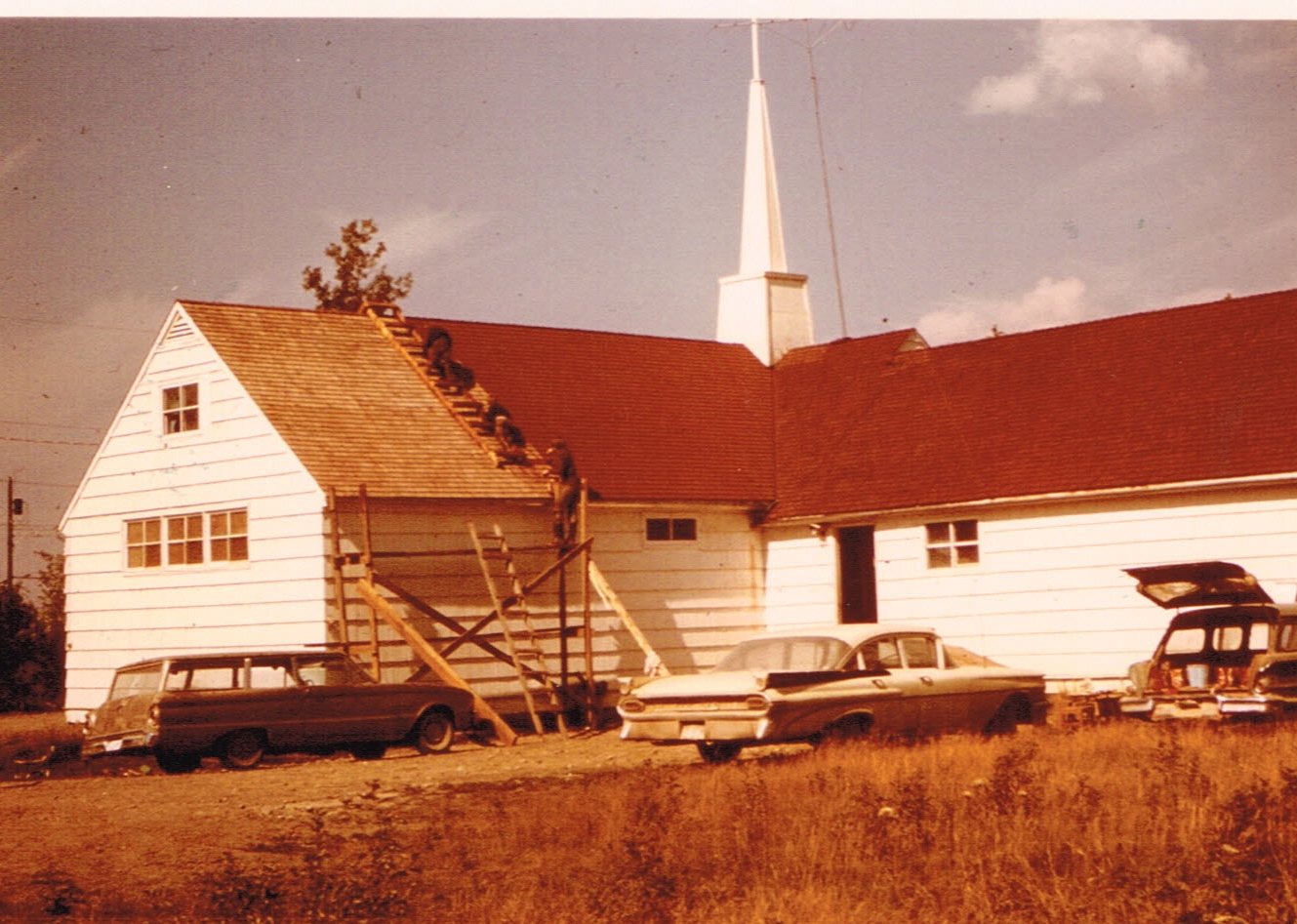 The LDS meetinghouse in Fort St. James was originally a Hudson’s Bay store. It was later sold to help build a meetinghouse in Vanderhoof. (Jane Chromarty)
The LDS meetinghouse in Fort St. James was originally a Hudson’s Bay store. It was later sold to help build a meetinghouse in Vanderhoof. (Jane Chromarty)
The Northern Interior Branch was dissolved in 1972, and its members joined the Vanderhoof Branch, forty miles to the south. The sawmills had become unprofitable, and the summer visitors stopped coming to Fort St. James. The large meetinghouse became too expensive to maintain and was sold. It became the courthouse and government office building for Fort St. James. The sale made it possible to build a new meetinghouse in Vanderhoof, where a number of families had moved from the United States to build permanent homes in the community. Glen and Judy Gwilliam and their children moved to Vanderhoof from Idaho in the spring of 1962. They found one LDS woman and her two daughters holding Primary in their home. When several other member families moved into the area that summer, they made the trip to Fort St. James for meetings.[93] But things were about to change in the Nechako Valley during the summer of 1962, when the Gulbranson family arrived.
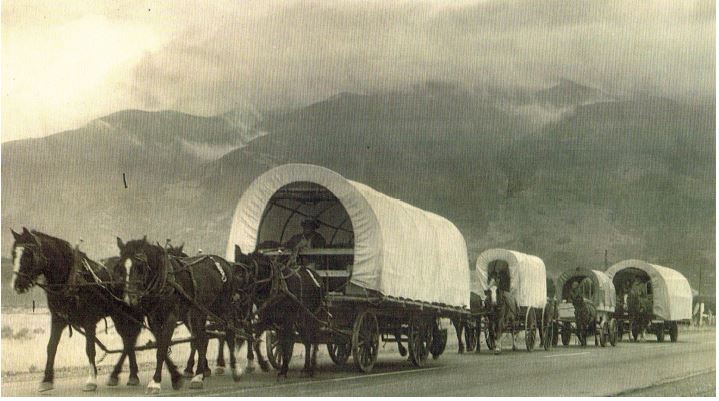 The Gulbranson family travelled by horse and covered wagon from Minnesota to Utah in 1962. Four years later, the family relocated to Vanderhoof, British Columbia, this time travelling by truck. (Melba Gullbranson)
The Gulbranson family travelled by horse and covered wagon from Minnesota to Utah in 1962. Four years later, the family relocated to Vanderhoof, British Columbia, this time travelling by truck. (Melba Gullbranson)
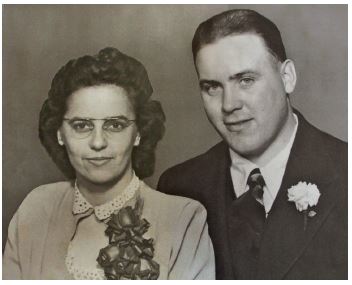 Orin and Mabel Gulbranson were twentieth-century Mormon pioneers in Vanderhoof. (Melba Gulbranson)
Orin and Mabel Gulbranson were twentieth-century Mormon pioneers in Vanderhoof. (Melba Gulbranson)
The move-in of the stalwart Gulbranson family prompted Milton L. Weilenman, president of the Alaskan-Canadian Mission, to say that he felt Vanderhoof would become the centre of the Church in the Central Interior.[97] The little congregation moved forward with faith. After renting several unsuitable venues for their meetings, the members built their own meetinghouse. Unfortunately, it was a poor structure with no insulation and only plastic in the windows, so after a hard winter in the small building, the Church members decided that they needed a proper LDS building. Considerable sacrifice of time, talents, and financial resources were required to see the building completed, and the proceeds of the sale of the Fort St. James building helped to make it possible. A three-phase building was dedicated at Vanderhoof on 26 September 1976. Vanderhoof went on to become the core of the expanding district throughout the late 1970s and 1980s.[98]
The town of Vanderhoof presents somewhat of an anomaly in British Columbia. Located in what is regarded by the Lower Mainlanders as the far north but which in reality is the geographic centre of the province, it has had two robust wards throughout the latter part of the last century, comprising almost half the town’s population. Many young people, including both members and nonmembers, were encouraged by leaders to participate in a full slate of Scouting, Mutual, and sporting activities. This, combined with a very well-attended seminary program, was designed to keep the youth occupied and ensure that they would be an important force for good in the town. Latter-day Saint youth were particularly active in high school sports. They were prominent players on the local basketball and volleyball teams. No other place in the province offered the advantages to the youth as this small town with its large LDS population. Approximately 140 missionaries were sent out from Vanderhoof over the years. Most of these young members had to leave the town to pursue postsecondary education and employment, and as a result, some of the second and third generation families have not been able to return to settle. But they will always remember Vanderhoof as a great place to be raised a Mormon.[99]
Administering the vast Cariboo District posed significant challenges. In 1973, the western portion of the district was constituted as the Terrace District, and in 1975, the remaining part of the Cariboo District was renamed the Prince George District. Three years later, the two districts were recombined as the Prince George Terrace British Columbia District, but in 1980 they were again divided into the Prince George and Terrace Districts.[100]
Continued growth over the years resulted in the creation of the Prince George British Columbia Stake, the sixth stake in the province, in 1992. The new stake consisted of two wards in Prince George, two wards in Vanderhoof, and one in Quesnel, as well as several branches. In 2016, there were four branches in the stake, including Bella Coola, Burns Lake, One Hundred Mile House, and Williams Lake. Bryce Gurney was the first stake president.[101]
The Terrace District continued in existence and in 2016 consisted of four branches: Terrace, Smithers, Kitimat, and Prince Rupert.[102]
Church Educational System (CES) teachers have made a particularly important contribution in the development of the Church in the central interior of British Columbia. There were Church members in several remote areas of the Cariboo/
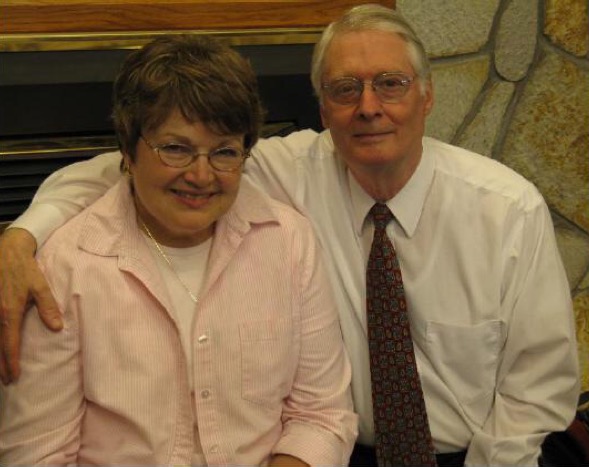 Allan Fletcher, a seminary and institute teacher, and his wife, Elaine, were among the many CES personnel who made significant contributions to the growth of the Church in British Columbia.[104] (Allan Fletcher)
Allan Fletcher, a seminary and institute teacher, and his wife, Elaine, were among the many CES personnel who made significant contributions to the growth of the Church in British Columbia.[104] (Allan Fletcher)
The Social and Cultural Lives of BC Members
It is clear from the record and the memories of the Saints that the major effort of the members in the first half of the twentieth century was simply to find one another, to get together as often as possible for mutual spiritual edification, and to build enduring friendships in social gatherings. Most congregations proceeded in the same pattern. Once they had coalesced as a group, and after meeting in numerous makeshift spaces and rented halls, the Saints felt a pressing need for buildings of their own. That meant fund-raising, and so they poured their hearts, minds, and energies into earning and saving money to build meetinghouses. Members sacrificed their savings, their time, and their labour toward achieving this goal. There are many fond, and perhaps not so fond, memories of bake sales, chocolate-making projects, sewing and quilting bees, bazaars, flyer and telephone-book deliveries, and many other activities that went into the effort. The fund-raising projects served many functions. They strengthened members’ faith and commitment to the gospel. They united them and taught them to work and serve together. The achievement of their goals provided reasons to celebrate together and to feel a sense of ownership when they could finally worship in their own buildings. It was a great training ground for service in the Church, and the presence of a building in the community drew the attention of others and often curiosity about the gospel.[105]
Brief histories of the growth of the Church outside of Utah are often replete with the names of priesthood leaders and the dates of building dedications. These facts tell only part of the story. The strength of a branch was based in large part on the dedicated service of the women, who organized and managed the innumerable activities as well as their homes and families, trying to keep their children close to the gospel by their teachings and examples. In many instances they assumed the tasks associated with fund-raising, until each area of the Church had at least one building in which to meet for worship and for socializing.[106]
A Church building meant local Latter-day Saints could plan and carry out more ambitious activities for children, youth, and adults. In the 1950s and 1960s, members were drawn to the chapels from long distances to participate in activities that included dance festivals, theatrical productions, gold and green balls, sporting events, and quarterly conferences. Gold and green balls were formal dances sponsored by the Mutual Improvement Association (MIA) and were often the highlight of the year’s activities. In 1961, the first stake auxiliaries were organized in Vancouver, and it was often these leaders in every stake who instigated and carried out social and cultural activities for their members.[107] In the 1970s, some of these events took on a life of their own, inspired in part by the travelling musical and theatrical groups that occasionally visited the province from Utah.[108] Many enjoyed visits from the Mormon Tabernacle Choir[109] and BYU entertainers, such as the Young Ambassadors and Lamanite Generation.[110] Stakes put on their own productions of Promised Valley, The Order Is Love, and Saturday’s Warrior.[111] Dance festivals, like the “Swinging Safari” festival held in Burnaby in 1965, would draw youth from throughout the mission to present the dances they had created and practiced in their own units.[112] Spring balls were an annual event in several stakes.[113]
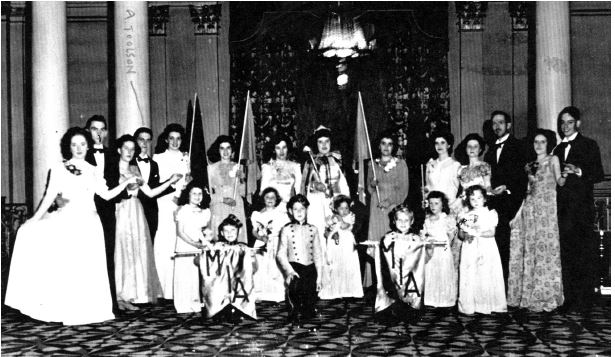 Gold and green balls, such as this one in the Hotel Vancouver about 1948, were held regularly in many Church units as a wholesome and culturally enriching activity. (Adrian Toolson)
Gold and green balls, such as this one in the Hotel Vancouver about 1948, were held regularly in many Church units as a wholesome and culturally enriching activity. (Adrian Toolson)
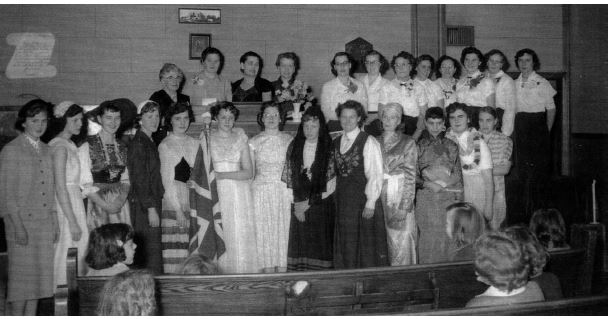 Women of the Cranbrook Relief Society, about 1958. (Jack Willicome)
Women of the Cranbrook Relief Society, about 1958. (Jack Willicome)
Planning and participating in cultural, athletic, and service activities provided experience and opportunities for the younger members to feel part of a large organization and helped to prepare them to serve. It gave them new opportunities to introduce the gospel to their friends. Large-scale events also helped to train leaders in the wards and branches that were being created outside of the major cities. As members moved to the suburbs and smaller communities in the province, they took with them the skills and experience needed to lead and strengthen new branches and wards.
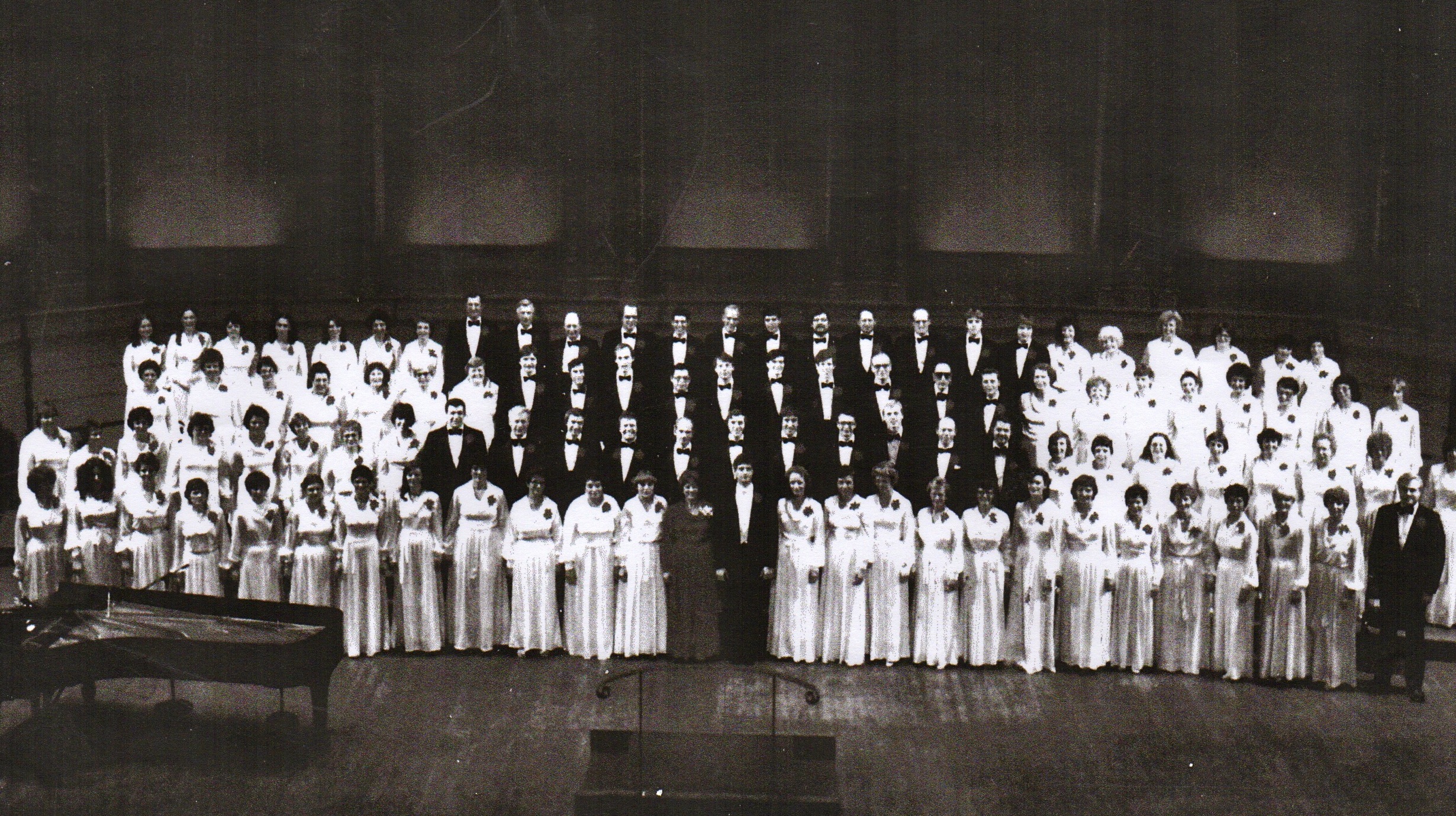 The “Christmas Is” Concert was held in the Vogue Theatre in Vancouver each Christmas season from 1987 to 1993. (Adrian Toolson)
The “Christmas Is” Concert was held in the Vogue Theatre in Vancouver each Christmas season from 1987 to 1993. (Adrian Toolson)
During the 1970s and 1980s, there was a general resurgence of interest by the Church in education. Seminary and institute directors were sent to take up residence in BC to service the CES programs for the youth and young adults. Early-morning seminaries were established in every ward, beginning in Vancouver in 1962.[114] Institute classes were set up near university and college campuses, and the Church Educational System sent speakers from the Church colleges to give seminars for adults during annual Education Week events. This service also increased interest in and availability of Church literature, broadening exposure to the principles of the gospel. The Churchwide curriculum was revised to focus on study of the scriptures, to better prepare the young men to serve missions, and to encourage enrollment in postsecondary education, especially at Brigham Young University in Utah and Rick’s College in Idaho. The need to serve missions was reinforced, and growing numbers of BC youth were answering that call. Family history libraries were set up in many Church buildings, giving members and nonmembers alike the opportunity to research their family’s genealogy using microfiche, films, and other resources from the Family History Library in Salt Lake City.[115]
Senior couple missionaries were sent out in great numbers during these years. Many of them have given faithful service in distant lands, but many others were assigned to become supportive members or leaders of the small branches within the mission or stakes. These faithful leaders, who had gained their experience within larger congregations, blessed the lives of new members and less-experienced leaders in Sechelt, Squamish, Merritt, Clearwater, and many other small towns in BC. They forged the pathway to growth throughout the province.
In the early 1980s, in response to an economic downturn and higher costs for fuel, the Church amalgamated Sunday and auxiliary meetings, reducing the need to drive to the buildings during the week. The Church also assumed the costs for new buildings and budgeted activities. While it meant the winding-down of fund-raising activities, it also had the effect of discouraging large-scale productions and district-wide and stake-centred activities. More and more ward and branch buildings were erected, situated closer to the members, and they accommodated smaller-scaled activities for youth and wards and branhes. Roadshows, potluck dinners, games nights, Saturday-night dances, and pickup sporting activities took the place of many big stake and district-wide events. It meant that there was more associating with local members and the community—not unlike the early days of branch building. At the same time, there was a renewed focus on province-wide Scout jamborees,[116] girls’ camps, and youth conferences so that young people could have a broader range of associations throughout the stakes and districts.
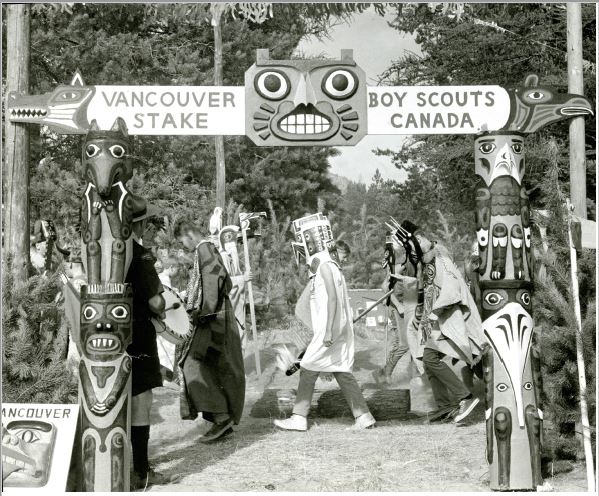 Burnaby Scouts at Farragut Jamboree in Idaho in 1966. Participation in Scouting has been an important element of the Church youth program. In this photograph, Scouts share aspects of BC aboriginal culture with their American counterparts. (Edna Penn Collection)
Burnaby Scouts at Farragut Jamboree in Idaho in 1966. Participation in Scouting has been an important element of the Church youth program. In this photograph, Scouts share aspects of BC aboriginal culture with their American counterparts. (Edna Penn Collection)
The 1990s also saw the first pioneer treks for the youth of most stakes. Once in every four years, each stake organized a three- or four-day event in which the youth, dressed in pioneer outfits, pushed and pulled handmade handcarts over many miles of rough terrain, simulating the early Mormon pioneer experience. These occasions continue to stand out in the memory of every young person who participated. Ward and stake young men and young women leaders put in innumerable hours of service to make such events the means of increasing the faith and testimony of the youth.[117] Youth were also encouraged to participate in stake sports events, including annual softball, basketball, volleyball, and floor-hockey tournaments. Some of these were deemed too competitive and damaging to the Church facilities and were curtailed to some degree in 1985.[118] Members in the Lower Mainland enjoyed an annual track and field day held at Stanley Park. The Vernon Stake continues to hold an annual marathon for walkers and cyclists.
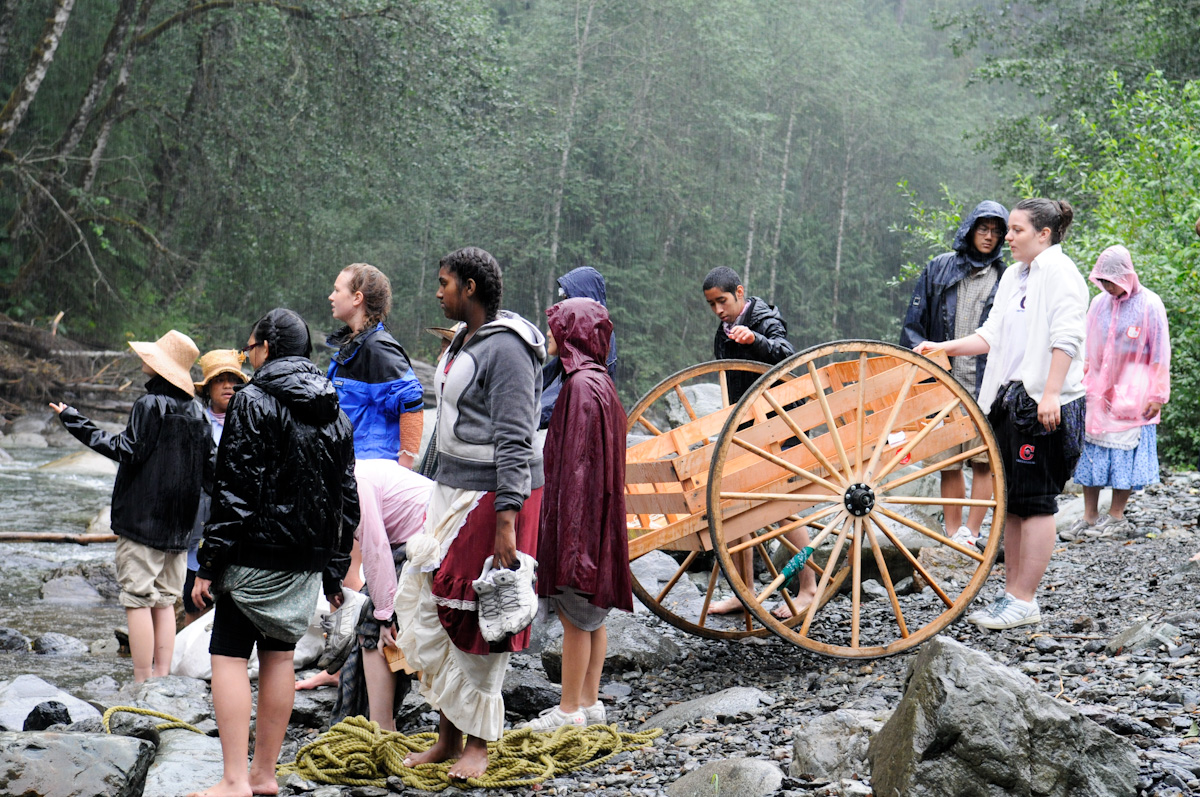 Pioneer treks were held periodically in most British Columbia stakes to give youth a meaningful pioneering experience and to strengthen faith and testimony. (John McCulloch)
Pioneer treks were held periodically in most British Columbia stakes to give youth a meaningful pioneering experience and to strengthen faith and testimony. (John McCulloch)
The Vernon, Surrey, and Cranbrook stakes shouldered the responsibilities of Church-owned orchards and farms as part of the Church Welfare Services program. Members from throughout the region participated in planting, pruning, weeding, and harvesting the produce of those farms. Church welfare services discontinued the farms and orchards in the early 2000s, but efforts to help the poor and needy have not ceased. A province-wide service activity was adopted in 2010, known as the annual British Columbia Thanksgiving Food Drive. The Church, in cooperation with local businesses, sponsors and provides volunteers in almost every community to collect food to restock the shelves of local food banks. In 2015, five thousand volunteers participated in the drive, which gathered and donated over 430,000 pounds, or more than one million dollars’ worth, of food.[119]
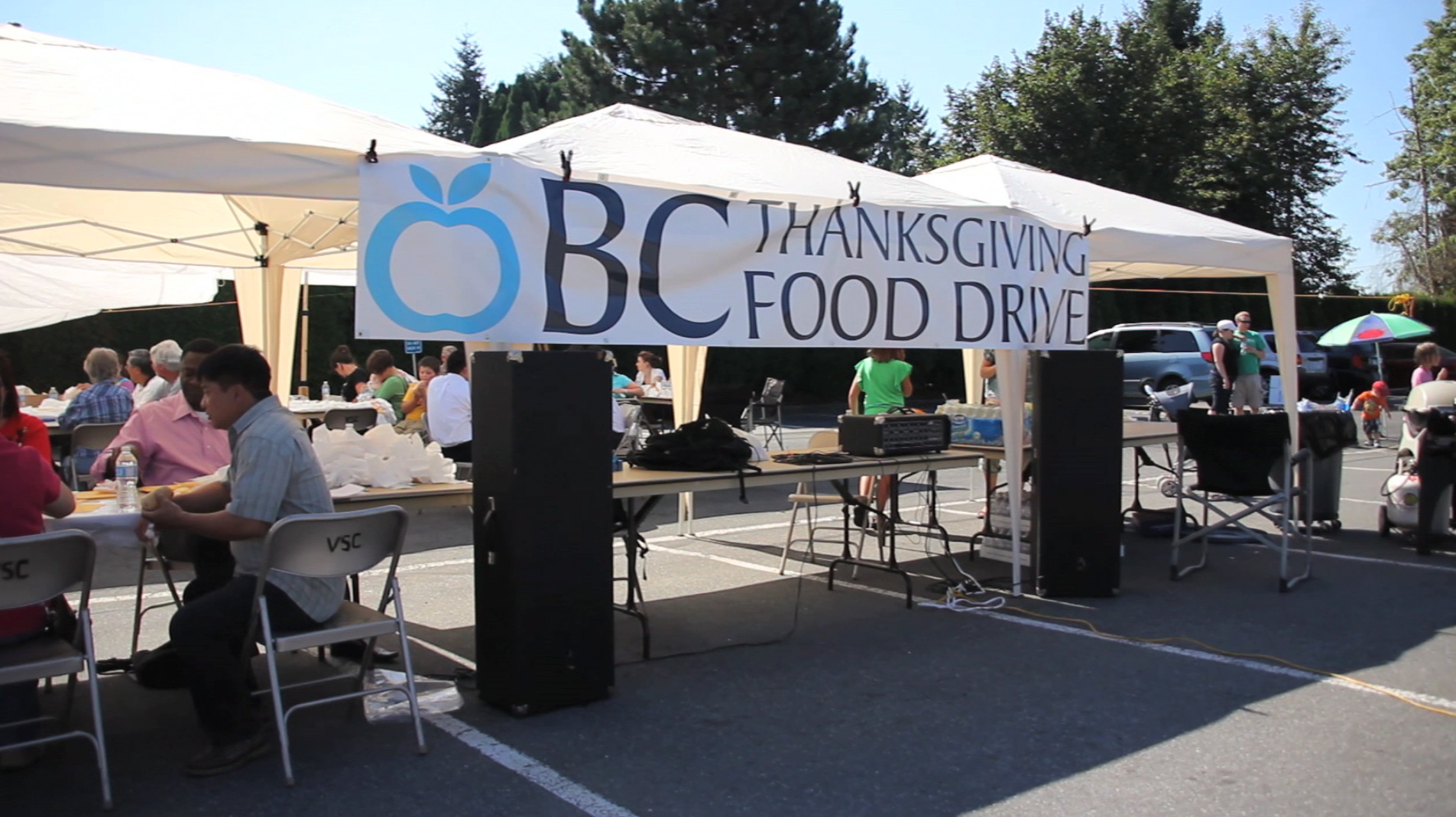 Providing meaningful service in the community is an important dimension of twenty-first-century Latter-day Saint activity. In this example from Burnaby, the annual BC Thanksgiving Food Drive provides substantial assistance to local food banks. (John McCulloch)
Providing meaningful service in the community is an important dimension of twenty-first-century Latter-day Saint activity. In this example from Burnaby, the annual BC Thanksgiving Food Drive provides substantial assistance to local food banks. (John McCulloch)
Another annual tradition which gained momentum during the 1990s and continued into the twenty-first century is crèche exhibits or nativity festivals, set up during the Christmas season in many meetinghouses, where the community is invited to share in an LDS view of Christmas. In addition to beautifully arranged displays of nativity sets, these events often also include choirs and dramatizations of the nativity. In many areas, particularly in the Vernon, Victoria, and Abbotsford stakes, the festivals attract strong attendance from nonmembers.[120]
When it was announced in 2006 that Vancouver would be getting a temple, the three stakes in the Lower Mainland wanted to see a trial run of a large production in preparation for the temple youth celebration. Over two hundred members of the Vancouver, Surrey, and Abbotsford stakes participated in three performances in the historic Massey Theatre in New Westminster to celebrate the diverse cultures that are represented in the stakes of the Lower Mainland. “Every Nation, Every People” featured dance and musical performances from each of the ethnic groups. Each performance began with a story told by a child of how his or her family first came to British Columbia. Ruth Yates was the creative director, and Shelley Murley composed several musical numbers for this event that would be reprised in the temple celebration event, which she coordinated three years later.[121]
 Filipinos in 2007 cultural celebration. The “Every Nation, Every People” production, presented by the three stakes of the Lower Mainland at the Massey Theatre in New Westminster in 2007, showcased the rich cultural heritage of the many ethnic communities in the area. (Shelley Murley)
Filipinos in 2007 cultural celebration. The “Every Nation, Every People” production, presented by the three stakes of the Lower Mainland at the Massey Theatre in New Westminster in 2007, showcased the rich cultural heritage of the many ethnic communities in the area. (Shelley Murley)
The Vancouver British Columbia Temple: The Culmination of 100 Years of Service
During the 1990s, in particular, there were many immigrants from Asia and South and Central America flowing into the Vancouver area, some of them already Church members and many others ready to accept the gospel of Jesus Christ. Mandarin-, Cantonese-, and Spanish-speaking missionaries laboured amongst the newcomers, and soon there were branches created to address their various language needs. Toward the end of the decade, and partly because the new immigrants had particular difficulties crossing the border into the United States to attend the temple in Seattle, Jon F. Tollestrup, president of the Vancouver Stake, felt the need to pursue having a temple in the Lower Mainland. This became a pressing need after 2001, with the increased border vigilance as a result of the terrorist attacks in New York. Cordell Rolfson and Thomas Walker, who followed Tollestrup in succession as stake president, were encouraged that more, smaller temples were being built throughout the world and urged Church members to be “Temple Bound.”[122] Initial responses from the First Presidency to the requests for a temple in Vancouver were that they should be patient. The patience and persistence of leaders and members was rewarded when it was announced, in 2006, that the Vancouver Saints would indeed have a temple of their own.[123]
Gordon B. Hinckley, President of the Church, visited the Vancouver area in 2007 to select a site for the new temple. After viewing several possible temple sites that had been preselected for his consideration, President Hinckley focused his attention instead on a piece of land that was not on the list, nor was it available. With instructions to “make it happen,” Paul Christensen, president of the Abbotsford Stake, used his influence to persuade the owners to sell and the city of Langley to approve the beautiful site, where over the next two years, a house of the Lord was built.[124] Thomas S. Monson, who was also present when the site was selected, returned on 2 May 2010 to offer the dedicatory prayer. President Monson’s hearty approval of the pre dedication cultural celebration cheered the 1,200 youth from across the province and northwest Washington state, who, in song and dance, paid tribute to the devotion and sacrifice of the pioneers that had made the temple possible.[125]
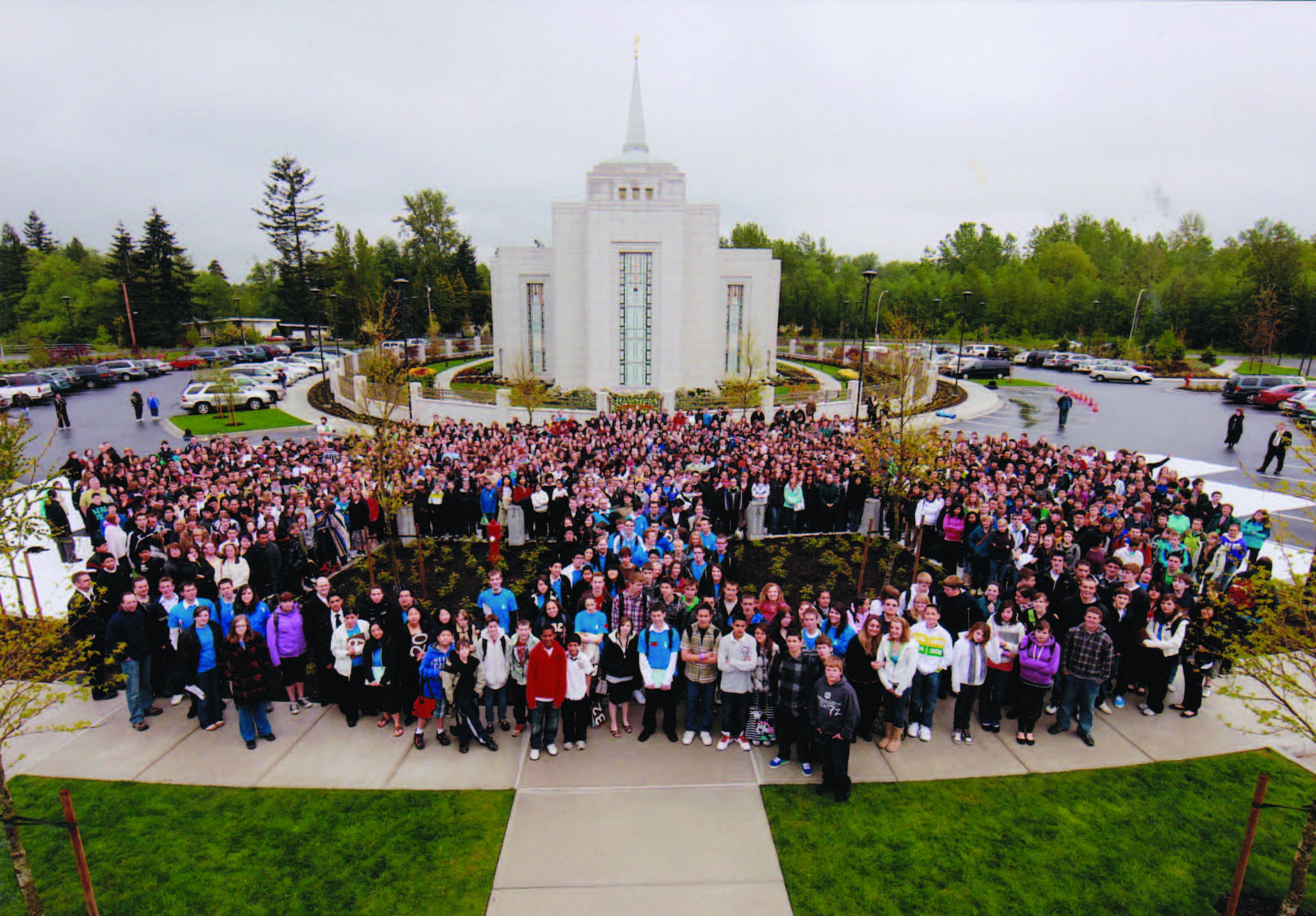 Hundreds of youth, preparing for the prededication youth temple-celebration event, gathered in front of the Vancouver Temple in 2010. (John McCulloch)
Hundreds of youth, preparing for the prededication youth temple-celebration event, gathered in front of the Vancouver Temple in 2010. (John McCulloch)
Cordell Rolfson, former president of the Vancouver Stake, was the first temple president, with Ronald Komm, also a former president of the Vancouver Stake, and Ronald Burnham, former president of the Vernon Stake and a counselor in the Seattle Temple presidency, as counselors. The first ordinances were performed in the Vancouver Temple on 4 May 2010 and have continued with dedicated service and attendance by members from across the province and northwest Washington State.
The temple dedication drew people from every part of the temple district. Six British Columbia stakes and two from northwest Washington prepared dance segments for the youth cultural event held in Langley the night before the temple dedication.[126] Twelve hundred young people and a delighted audience celebrated the history of the Church in British Columbia. It honoured the first LDS family in BC, the Copleys on Vancouver Island, and many others who were Church pioneers in the province. As some of the oldest members of the Church in BC walked onto the floor at the youth cultural event and their stories were told in song and dance, the audience gratefully acknowledged the effort and sacrifices made by these noble and great ones who had laid the foundations to bring the Church in BC to the stage where the blessings of a temple could be available. The youth celebration dramatized the significant events in the province: the lives and culture of First Nations people; the coming of Europeans to BC to search for gold, to log, to fish, and to farm; the completion of the cross-country railroad; the Great Depression; the service given in aid of the forces in the Great Wars; the women in the workforce; and the immigration of Asian and South and Central American member families.[127]
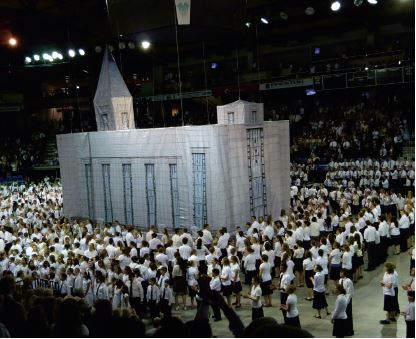 The dramatic highlight of the temple youth celebration in 2010 took place when, in the midst of hundreds of youth singing on the floor of the arena, a large inflated model of the temple rose up before an astonished audience. (John McCulloch)
The dramatic highlight of the temple youth celebration in 2010 took place when, in the midst of hundreds of youth singing on the floor of the arena, a large inflated model of the temple rose up before an astonished audience. (John McCulloch)
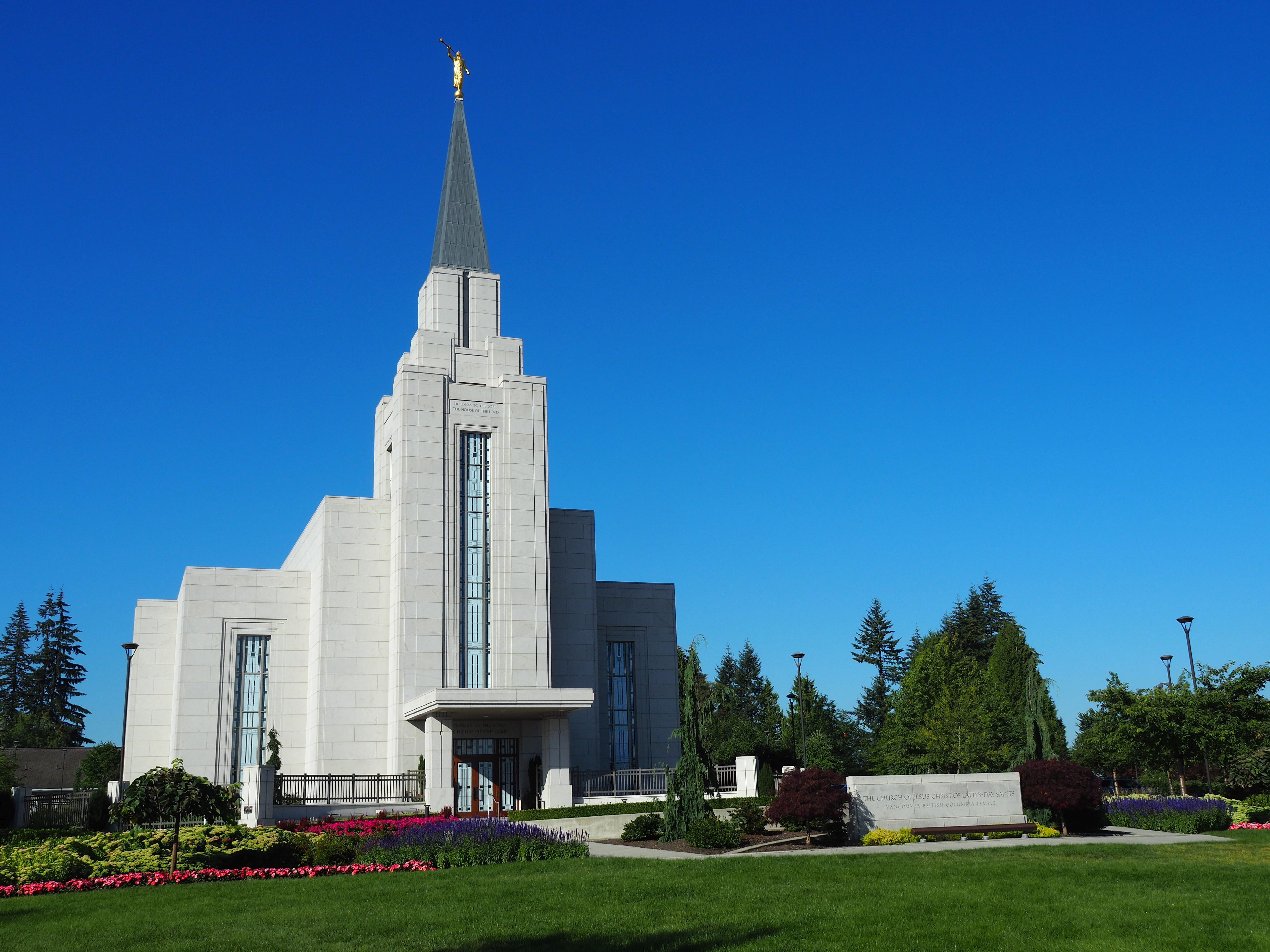 The beautiful Vancouver British Columbia Temple, the seventh temple in Canada, was dedicated in 2010. (Richard Yates)
The beautiful Vancouver British Columbia Temple, the seventh temple in Canada, was dedicated in 2010. (Richard Yates)
Just prior to the temple dedication, Paul Christensen, president of the Abbotsford Stake, who had overseen the preparation of land and construction of the temple, was called to serve as an Area Seventy, a member of the Fifth Quorum of Seventy.[128] In that capacity, he organized the committee to develop the Canadian branch of lds.org, one of the first of lds.org global/
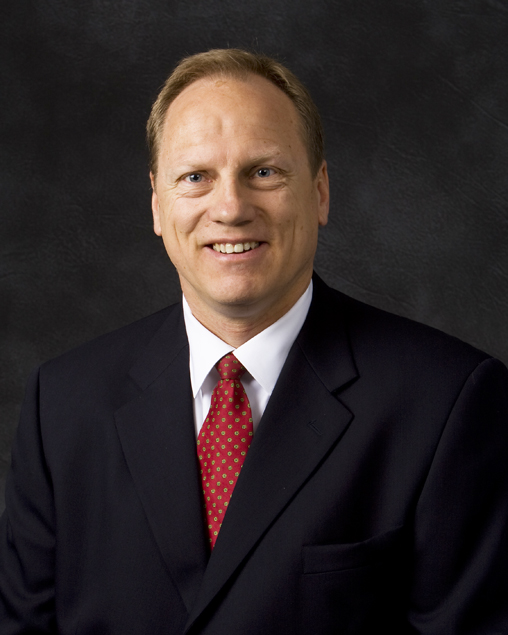 In 2010, Paul Christensen, former president of the Abbotsford Stake, became the first Area Seventy called from British Columbia. (Paul Christensen)
In 2010, Paul Christensen, former president of the Abbotsford Stake, became the first Area Seventy called from British Columbia. (Paul Christensen)
Conclusion
In 2016, there were approximately thirty thousand members of the Church in British Columbia, eight stakes, one district, and eighty congregations.[130] The Vancouver British Columbia Temple, in operation for six years, had become the destination of many of the faithful Saints in the province, some of whom regularly travelled more than one thousand kilometres to render sacred service there. Righteous pioneers in British Columbia throughout its history are remembered in this history for their devotion. They continue to serve, lead, and train the precious Saints of the province, who will be the subjects of histories yet to be written.
Notes
[1] Basic sources on the history of the Church in British Columbia include: Lethbridge Stake, A History of the Mormon Church in Canada (Lethbridge, Alberta: Corporation of the President, Lethbridge Department 1968) [This volume, undertaken as a Canadian Centennial Project, was compiled and edited by a committee appointed by the presidency of the Lethbridge Stake and included Melvin S. Tagg, who summarized the history of the various branches and wards of the LDS Church in Canada until 1966.]; Robert J. McCue, “The Church of Jesus Christ of Latter-day Saints and Vancouver Island: The Establishment and Growth of the Mormon Community,” BC Studies, Summer, 1979; Also, Robert J. McCue “The Saints on Vancouver Island,” Ensign, April 1976; Giles H. Florence Jr., “No One Is an Island,” Ensign, August 1990; Jackson Ellis, “A History of the Church on Vancouver Island,” Stake Media Package, 1999; “Called to Serve, Six Decades of the Vernon Branch/
The author of this study is particularly indebted to the several researchers who provided the archival documentation for this chapter while working on the “British Columbia profile” in the Church History Library, Salt Lake City, Utah, 2014–2016. These include Church service missionaries, Donald Schneider, Richard Vance, and Stephen Carter; and full-time missionaries, Serenity and Thomas Roulstone. Several photos came from the Edna Penn Collection.
[2] Times and Seasons 6 (1 November 1845), 1019, Church History Library, Salt Lake City (hereafter CHL), M205.1 T583 V6.
[3] 1846, Millennial Star, 20 November 1846, 142.
[4] Margaret A. Ormsby, British Columbia: A History (Vancouver, BC: Macmillan, 1958).
[5] https://
[6] Canadian Census Records, 1901, accessed 7 January 2015, ancestry.com. See also Special Victoria District Conference, The Church of Jesus Christ of Latter-day Saints, Capitol Theatre, Victoria, BC, 9 February 1975, folder 1, CHL, M277.11 S741 1975 c.2.
[7] Anthony Maitland Stenhouse of Comox, Stenhouse, D. R., folder 1, K2h 1–K2h 11, CHL, MS 6935.
[8] Oregon Portland Mission (hereafter OPM), Manuscript History and Historical Reports (hereafter MHHR), 14 May 1902, Northwestern States Mission, box 1, vol. 1, part 2, CHL, LR 9361 2. See also Special Victoria District Conference, The Church of Jesus Christ of Latter-day Saints, Capitol Theatre, Victoria, BC, 9 February 1975, folder 1, CHL, M277.11 S741 1975 c.2.
[9] OPM, MHHR, 16 July 1904, box 1, vol. 1, part 2, CHL, LR 9361 2.
[10] “Called to Serve: Six Decades of the Vernon Branch History,” 1, 4.
[11] An example of such a compilation is a book still in draft form by Patricia Steves, formerly of the Terrace District. As It Was is a collection of the family stories of members of the Terrace District from its beginnings in the mid-1960s until the present day. Such collections are of great value in making the history of the Church.
[12] Yvonne Salter interview, August 2014, interviewed by Ruth Whidden Yates, interview in possession of author. Photo provided and with permission to use from Yvonne Salter, July 2016.
[13] Cordell Rolfson interview, 9 September 2015, interviewed by Ruth Yates, Langley, British Columbia, CHL, OH 8460.
[14] Hattie Baker Jensen, “Hattie Baker Jensen: My Life Story,” 124–26, FamilySearch, https://
[15] Joe and Joan Hall and Linda Ripplinger, “Joining Hands in Community Service,” http://
[16] Lynda Peterson to Thomas Baird Roulstone, email, 25 May 2016.
[17] OPM, MHHR, 14 July 1904, box 1, vol. 1, part 2, CHL, LR 9361 2; Jane Sutherland Davidson, “Autobiography of Jane Sutherland Davidson,” 19 November 2013, familysearch.org/
[18] OPM, MHHR, 6 April 1909, Northwestern States Mission, box 1, vol. 1, part 3, CHL, LR 9361 2; Vancouver British Columbia Ward General Minutes; for examples, see 23 April 1911, page 9, folder 9, 4 January 1914, page 22 and 7 July 1918, pages 150–51, folder 11, CHL, LR 9699 11.
[19] Sarah Broom Delong with Dennis A. Wright, Vancouver Saints, 1845–2007 (2009), 15.
[20] Ibid., 9; See also Edwin Emerson Pinckney, https://
[21] Vancouver Stake 1920’s—Rimmer Family with Photos, Abbotsford British Columbia Stake Records, 1939, 1942–1980, 1984–85, 1988, 1992–13, CHL, LR 522783 24.
[22] Vancouver Stake 1920’s, 9–10.
[23] Vancouver Stake, 1904–52, history retyped by Jean Davie, 2005, 5, Abbotsford British Columbia Stake Records, 1939, 1942–80, 1984–85, 1988, 1992–2013, CHL, LR 522783 24.
[24] Alaskan-Canadian Mission History of Church in Canada Project Files, The History of the Vancouver Stake, 1904–67, 19, box 1, folder 35, CHL, LR 10530 29.
[25] OPM, MHHR, Northwestern States Mission, box 3, vol. 5, part 1, 30 November 1947, CHL, LR 9361 2.
[26] Vancouver District General Minutes, folder v. 1, 6 May 1948, CHL, LR 17094 11.
[27] Alden Smith interview, 23 June 2016, interview by Ruth Yates, Langley, BC, CHL (not yet catalogued).
[28] New Westminster Ward General Minutes, 1942–77, folder 1, CHL, LR 6045 11.
[29] Gabrielle Tambre Steed interview, February 2010, interview by Jean Copley Davie, in possession of Gabrielle Steed, Coquitlam, BC.
[30] Recollection of his eldest son, Edward (Ted) Burgess, Langley, BC, May 2016.
[31] Canada Calgary Mission (hereafter CCM), MHHR, 1 August 1954, box 1, volume 1, folder 1, CHL, LR 10539 2; President David O. McKay, from his remarks opening the second session of dedicatory meetings, Dedicatory prayer cited in Delong and Wright, Vancouver Saints, 22.
[32] Vancouver British Columbia Stake MHHR, 1960, folder 1, CHL, LR 9703 2.
[33] Alaskan-Canadian Mission History of Church in Canada project files, The History of the Vancouver Stake 1904-1967, 21 November 1960, 6, box 1, folder 35, CHL, LR 10530 29.
[34] Vancouver Stake 25th Anniversary Celebration Program Script, 1985, 4, Abbotsford British Columbia Stake Records, 1939, 1942–80, 1984–85, 1988, 1992–2013, CHL, LR 522783 24.
[35] Vancouver Stake Anniversary Celebration Program Script, Va St 1985, Abbotsford British Columbia Stake Records, 1939, 1942–80, 1984–85, 1988, 1992–2013, CHL, LR 522783 24.
[36] Vancouver Stake Stake Center Dedication Booklet, 1967, Abbotsford British Columbia Stake Records, 1939, 1942–80, 1984–85, 1988, 1992–2013, CHL, LR 522783 24.
[37] Lethbridge Stake, A History of the Mormon Church in Canada (Lethbridge, Alberta: Lethbridge Stake, 1968), 287–91.
[38] Vancouver Stake 10th Anniversary Booklet, 1970, 10, Abbotsford British Columbia Stake Records, 1939, 1942–80, 1984–85, 1988, 1992–2013, CHL, LR 522783 24.
[39] Canadian Census Records, 1901, ancestry.com. See also Special Victoria District Conference, The Church of Jesus Christ of Latter-day Saints, Capitol Theatre, Victoria, BC, 9 February 1975, folder 1, CHL, M277.11 S741 1975 c.2.
[40] Alaskan-Canadian Mission History of Church in Canada Project Files, 1967, box 1, folder 33, CHL, LR 10530 29. See also Lasqueti Island Branch Sunday School Minutes and Records, 1933–48, CHL, LR 11701 15.
[41] Stephanie Mason Williams, a family history, “The History of the Church on Lasquetti Island.”
[42] Special Victoria District Conference, The Church of Jesus Christ of Latter-day Saints, Capitol Theatre, Victoria, BC, 9 February 1975, folder 1, CHL, M277.11 S741 1975 c.2.
[43] Special Victoria District Conference, 9 February 1975, folder 1, CHL, M277.11 S741 1975. See also Victoria First Ward Historical Information, Church Directory of Organizations and Leaders (hereafter CDOL), cdol.lds.org.
[44] Victoria District General Minutes, 1949, 1, folder 1, CHL, LR 9775 11.
[45] Special Victoria District Conference, 9 February 1975, folder 1, CHL, M277.11 S741 1975. See also CCM, MHHR, 1959, box 1, vol. 2, folder 2, CHL, LR 10539 2.
[46] Alaskan-Canadian Mission History of Church in Canada project files, The History of the Vancouver Stake, 1904–67, 21 November 1960, 6, box 1, folder 35, CHL, LR 10530 29.
[47] Powell River Branch MHHR, 1967–83, folder 1, CHL, LR 7165 2. See also Special Victoria District Conference, 9 February 1975, folder 1, CHL, M277.11 S741 1975.
[48] Special Victoria District Conference, 9 February 1975, folder 1, CHL, M277.11 S741 1975. See also Victoria Second Ward Historical Information, CDOL, cdol.lds.org.
[49] McCue, “The Saints on Vancouver Island,” Ensign, April 1976.
[50] Victoria British Columbia Stake MHHR, 1975, folder 1, CHL, LR 1469 2. See also Victoria Stake Historical Information, CDOL, cdol.lds.org.
[51] “The History of the Nanaimo British Columbia Stake,” October 1997, 6, CHL, CR 100 559.
[52] Nanaimo British Columbia Stake associated organizations, CDOL, cdol.lds.org.
[53] Jack Willicome interview, 10 June 2015, interviewed by Ruth Yates, Lethbridge, Alberta, CHL, 0H 8242; personal records of Darla O’Dell, early member and stake historian of the Cranbrook Stake.
[54] Alaskan-Canadian Mission History of the Church in Canada Project Files, 1967, box 2, folder 28, CHL, LR 10530 29; Vancouver District General Minutes, 25 July 1949, folder 1, CHL, LR 17094 11.
[55] Alaskan-Canadian Mission history of Church in Canada Project Files, A Brief History of the Creston Branch, 2 May 1948, box 2, folder 28, CHL, LR 10530 29. See also Creston Branch, Manuscript, CHL, MS 4318; Creston Ward, CDOL, cdol.lds.org.
[56] Jack Willicome, interviewed by Ruth Yates, 10 June 2015, Lethbridge, Alberta, CHL, 0H 8242; personal records of Darla O’Dell, early member and stake historian of the Cranbrook Stake.
[57] Nena Jean Trimble, article in Cranbrook & District Key City Chronicles, 1979.
[58] Kootenay District MHHR, 1960, CHL, LR 4511 2. See also Lethbridge Stake, Mormon Church in Canada, 287–91; Alaskan-Canadian Mission History of Church in Canada Project Files, 1967, box 1, folder 9, CHL, LR 10530 29.
[59] Cranbrook British Columbia Stake Annual Historical Reports, 1979, folder 3, CHL, LR 19154 3. See also Canada Vancouver Mission Annual Historical Reports, 14 January 1979, box 1, folder 1, CHL, LR 10530 3.
[60] Darla O'Dell, Cranbrook Stake Historian, telephone interview with Ruth Yates, June 2014.
[61] Cranbrook British Columbia Stake, associated organizations, CDOL, cdol.lds.org.
[62] Adapted from Shauna Salmon, “Sparwood, BC-Tragedy and Triumph Unites a Community,” canada.lds.org.
[63] Alaskan-Canadian Mission History of Church in Canada Project Files, 1967, box 1, folder 9, CHL, LR 10530 29.
[64] Kamloops Branch History, Alaskan-Canadian Mission History of Church in Canada Project Files, 1967, box 1, folder 9, CHL, LR 10530 29.
[65] Alaskan-Canadian Mission History of Church in Canada Project Files, 1967, box 1, folder 22, CHL, LR 10530 29.
[66] “Called to Serve: Six Decades of the Vernon Branch/
[67] “Called to Serve,” 7.
[68] Ronald J. Burnham and Shirley Burnham interview, 28 August 2015, interviewed by Ruth Yates, Vernon British Columbia, CHL, OH 8458.
[69] Ronald J. Burnham and Shirley Burnham interview.
[70] Vernon British Columbia Stake MHHR, 1977, CHL, LR 15054 2.
[71] Ronald J. Burnham, interviewed by Ruth Yates, 28 August 2015, CHL, OH 8458.
[72] “Called to Serve,” and information provided by Shirley Burnham of the Vernon Stake.
[73] “Called to Serve.”
[74] “Called to Serve.”
[75] Shirley Burnham interview, 28 August 2015, interviewed by Ruth Yates, CHL, OH 8458.
[76] Robert Graham interview, 11 September 2015, interviewed by Ruth Yates, Langley, British Columbia, CHL, OH 8584.
[77] Personal knowledge of author, 13 August 2016.
[78] CCM, MHHR, 4 January 1956, box 1, CHL, LR 10539 2. See also Lethbridge Stake, Mormon Church in Canada, 283.
[79] Carolyn Wheat, interviewed by Ruth Yates, 12 June 2015, Dawson Creek, British Columbia, CHL OH 8303; Judy Hawthorne interview, 13 June 2015, interviewed by Ruth Yates, Fort St. John, British Columbia, CHL, OH 8297.
[80] Judy Hawthorne interview, 13 June 2015, CHL, OH 8297.
[81] Judy Hawthorne interview.
[82] Alaskan-Canadian Mission History of Church in Canada Project Files, 1967, box 1, folder 9, CHL, LR 10530 29.
[83] Caribou District MHHR, 1961–83, CHL, LR 1427 2. See also Lethbridge Stake, Mormon Church in Canada, 295–98; Alaskan-Canadian Mission History of Church in Canada project files, Cariboo District, box 1, folder 33, 8, CHL, LR 10530 29.
[84] Fritz Duerichen to Ivan and Mabel Burgoyne, 17 September 1967, “History of the Home Sunday School in Doughty near Smithers, BC,” Alaskan-Canadian Mission History of Church in Canada Project Files, 1967, box 1, folder 17, CHL, LR 10530, 29.
[85] Fritz Duerichen to Ivan and Mabel Burgoyne.
[86] Fritz Duerichen to Ivan and Mabel Burgoyne.
[87] Fritz Duerichen to Ivan and Mabel Burgoyne.
[88] Fritz Duerichen to Ivan and Mabel Burgoyne.
[89] Allan Whidden (former district president) and Catherine Houston (history teacher in Haida Gwaii from 1974–81) interview, June 2014, interviewed by Ruth Yates, Vanderhoof, BC.
[90] Whidden and Houston interview.
[91] Lethbridge Stake, Mormon Church in Canada, 295.
[92] Jane Chromarty, “History of the Church in Fort St. James.”
[93] Jane Chromarty, “History of the Church in the Nechako Valley,” unpublished document by Jane Chromarty in possession of author.
[94] Doug Robinson, “A Family Experiences a True-Life Pioneer Trek—in 1962,” Deseret News, 10 July 2012; Mabel Gulbranson interview, 16 June 2015, interviewed by Ruth Yates, Vanderhoof, British Columbia, CHL, OH 8385.
[95] Robinson, “True-Life Pioneer Trek—in 1962.”
[96] Robinson, “True-Life Pioneer Trek—in 1962,”; Mabel Gulbranson interview, 16 June 2015.
[97] Caribou District MHHR, 1961–83, CHL, LR 1427 2. See also Alaskan-Canadian Mission History of Church in Canada Project Files, Cariboo District, box 1, folder 33, 8, CHL, LR 10530 29; Vanderhoof Branch Confidential Minutes, 1964, folder 1, CHL, LR 9705 10.
[98] Allan Whidden, former district president and bishop in Vanderhoof (service, from 1976 to 2016), interview with Ruth Yates, November 2014.
[99] From telephone conversations with Allan Whidden, former district president, bishop (also Scout leader and seminary teacher) in Vanderhoof, British Columbia.
[100] Terrace British Columbia District and Prince George British Columbia District, Historical Information and Associated Organizations, CDOL, cdol.lds.org.
[101] Prince George British Columbia Stake Historical Information, CDOL, cdol.lds.org.
[102] Terrace British Columbia District, Historical Information and Associated Organizations, CDOL, cdol.lds.org.
[103] Carl and Roberta Ekman interview, 8 October 2015, interviewed by Ruth Yates, Terrace British Columbia, CHL (not catalogued at time of writing).
[104] “It’s As It Was”: Stories of the Terrace District, collected by Patricia Steves, 2015.
[105] For example, in 1949 “successful” bazaars were held in the North Vancouver Branch and in the Cranbrook Branch. CCM, MHHR, 2 December 1949, box 1, vol. 1, folder 2, CHL, LR10539 2.
[106] CCM, MHHR, 10 December 1949, box 1, vol. 1, folder 2, CHL, LR10539 2.
[107] For a list of these officers, see Vancouver British Columbia Stake MHHR, 1960, CHL, LR 9703 2.
[108] For example, in June 1962 the Ogden Chorale performed in Vancouver and donated proceeds of their ticket sales to the stake building fund; Alaskan-Canadian Mission Church in Canada project file, Alice G. Wood, The History of the Vancouver Stake, page 4, box 1, folder 35, CHL, LR 10530 29.
[109] The Mormon Tabernacle Choir visited Vancouver in 1962 and Victoria in 1986 as part of the Expo celebrations. Vancouver British Columbia Stake MHHR, 14 August 1962, box 1, CHL, LR 9793 2; “Prominent Visitors to Expo 86,” accessed 24 June 2016, http://
[110] Lamanite Generation performed in Kamloops and Penticton in May 1977; Canada Vancouver Mission MHHR, 15 October 1974, folder 3, CHL, LR 10530 2.
[111] Vancouver and Abbotsford presented “Promised Valley” in 1988 and 1997 respectively. Vancouver British Columbia Stake Annual Historical Reports, May 1988, box 1, folder 1, CHL, LR 9703 3; Abbotsford Stake-Clearbrook 1997 Promised Valley production, Abbotsford British Columbia Stake records, 1939,1942–80, 1984–85, 1988, 1992–2013, CHL, LR 522783 24.
[112] Brent M. McMullin, comp., A History of the White Rock Ward (2013), 58, folder 1, CHL, LR 1013821.
[113] Including Dawson Creek in 1964. Peace River District MHHR, folder 1, 1st Quarterly Report 1964, CHL, LR 6816 2.
[114] North Shore Ward Confidential Minutes, 9 September 1962, folder 1s, CHL, LR 6199 10. An Indian seminary started in Port Alberni in 1964, Alaskan Canadian Mission History of the Church in Canada Project Files, 1967, box 2, folder 35, Missionary Work Among the Indians of British Columbia, CHL, LR 10532 29.
[115] Albert Penn was sustained as the first stake genealogical chairman in 1960. Lethbridge Stake, Mormon Church in Canada, 244.
[116] “About the Encampment,” ldsencampment.com/
[117] Paul J. Christensen interview, 10 September 2016, interviewed by Ruth Yates, CHL, OH 8464.
[118] Ruth Yates, personal knowledge, Vancouver Stake Young Women’s counselor and president during 1980s.
[119] bctfooddrive.org.
[120] Abbotsford Stake 1999—Annual Creche (Nativity) Exhibits Start at the Stake Centre, 2 December 1999, Abbotsford British Columbia Stake Records, 1939, 1942–80, 1984–85, 1988, 1992–2013, CHL, LR 522783 24.
[121] Vancouver Star: Canada Vancouver Newsletter, 17 July 2007, Canada Vancouver Mission Annual Historical Reports, box 1, folder 9, CHL, LR 10530 3. See also Tri-stake 2007—Every Nation Every People Production, Abbotsford British Columbia Stake Records, 1939, 1942–80, 1984–85, 1988, 1992–2013, CHL, LR 522783 24.
[122] Cordel and Marilyn Rolfson, interviewed by Ruth Yates, 9 September, 2015, Langley, British Columbia, CHL, OH 8460.
[123] “News of the Temples: Temple Announced for Vancouver, B.C.,” LDS Church News, 10 June 2006.
[124] Vancouver Star: Canada Vancouver Mission Newsletter, 7 August 2007, Canada Vancouver Mission Annual Historical Reports, box 1, folder 9, CHL, LR 10530 3.
[125] Sara Jane Weaver, “Church’s 131st Temple Dedicated,” Church News, 2 May 2010, =ldschurchnewsarchive.com/
[126] Sara Jane Weaver, “Church’s 131st Temple Dedicated.” See also Avant, “‘Beautiful Day.’”
[127] Sarah Jane Weaver, “Vancouver Youth Celebration: One Member, One Family, One Branch, One Testimony at a Time,” Church News, 2 May 2010, www.ldschurchnewsarchive.com/
[128] “Paul D. M. Christensen,” mormonnewsroom.ca/
[129] Canada.lds.org.
[130] http://
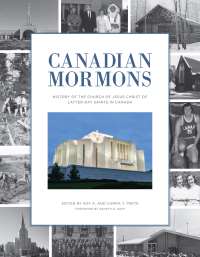
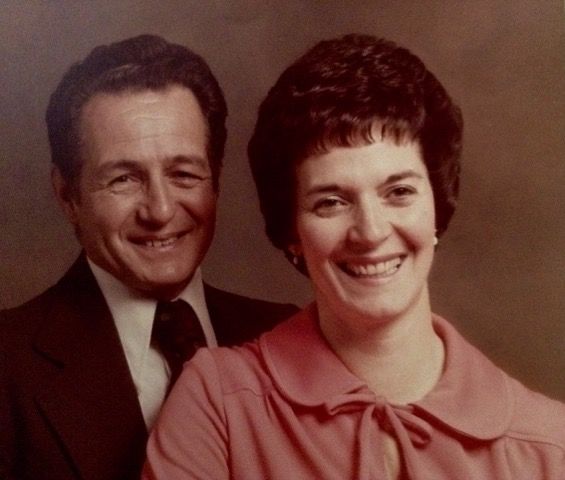 The Salters served in many locations throughout their life in BC. (Yvonne Salter)
The Salters served in many locations throughout their life in BC. (Yvonne Salter)